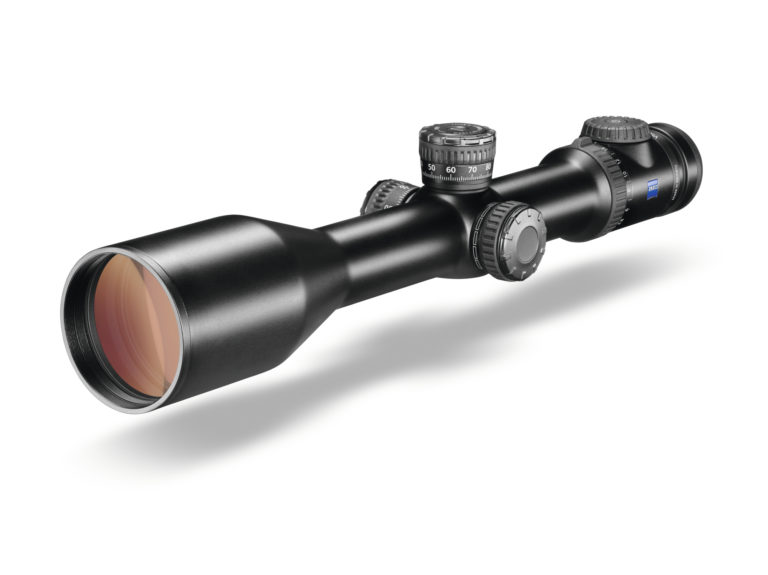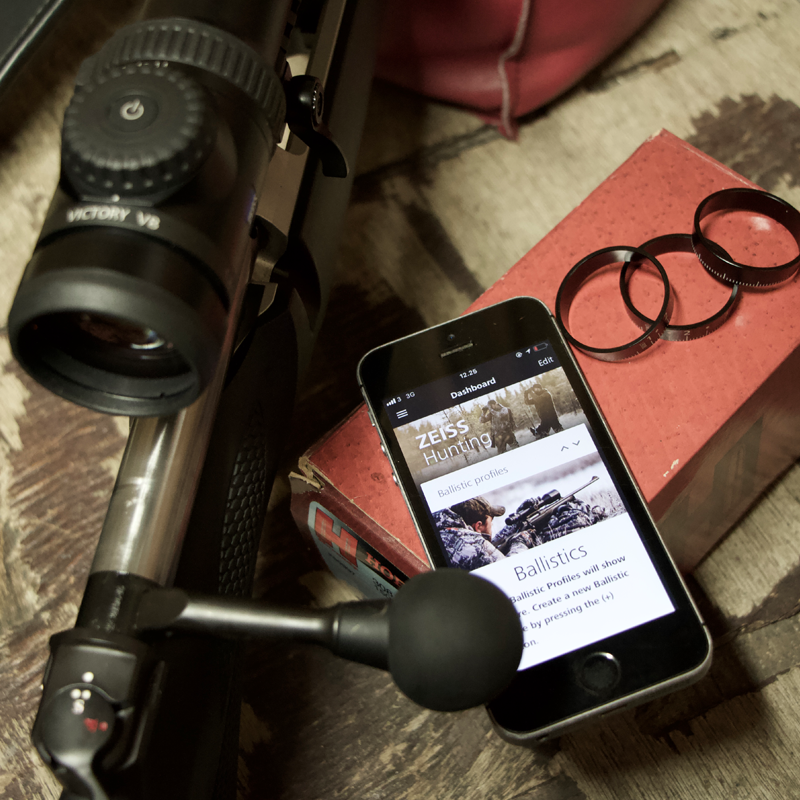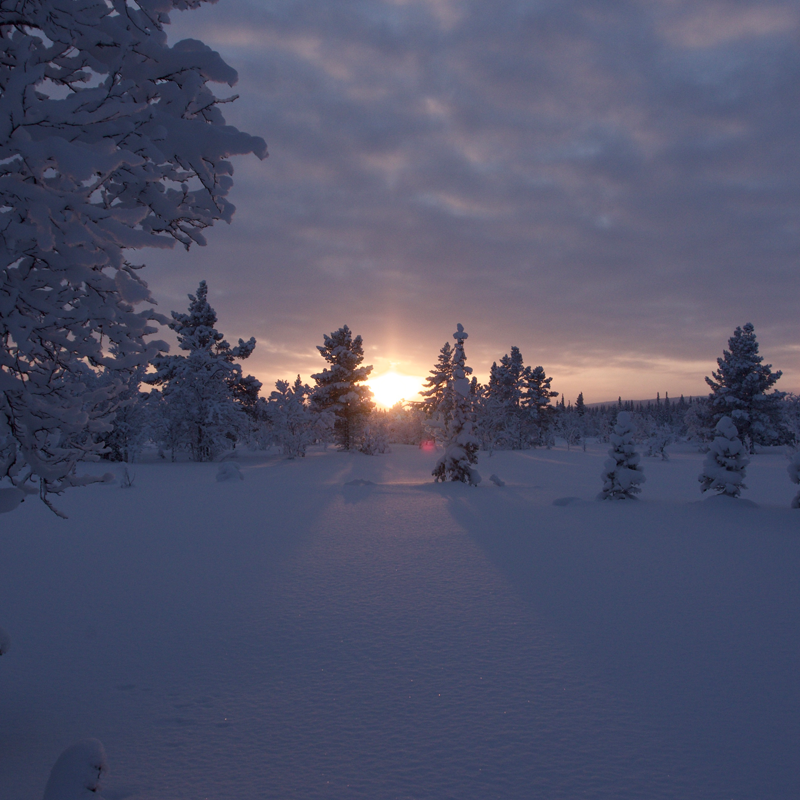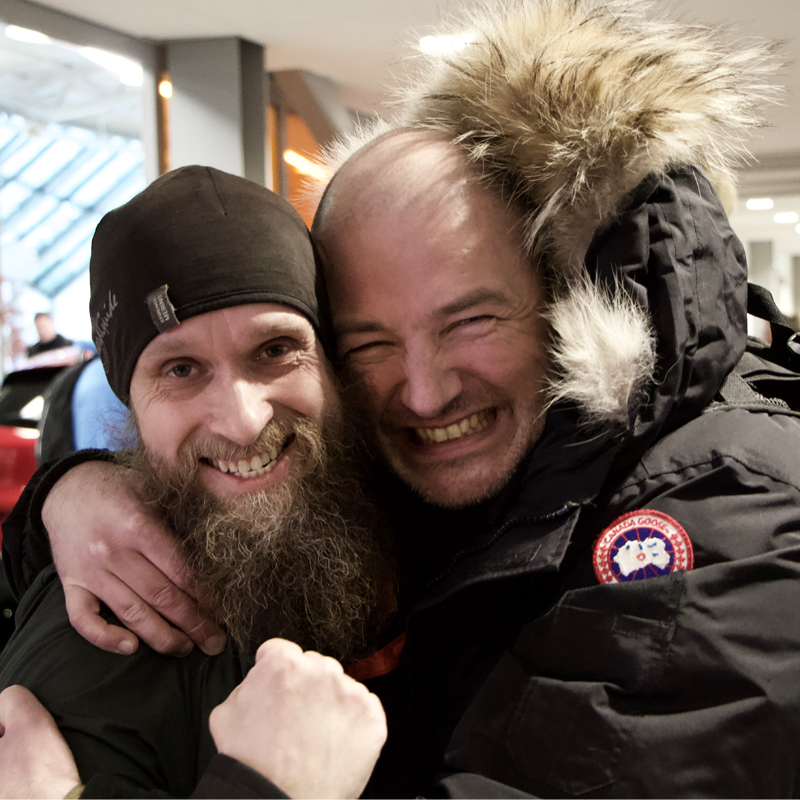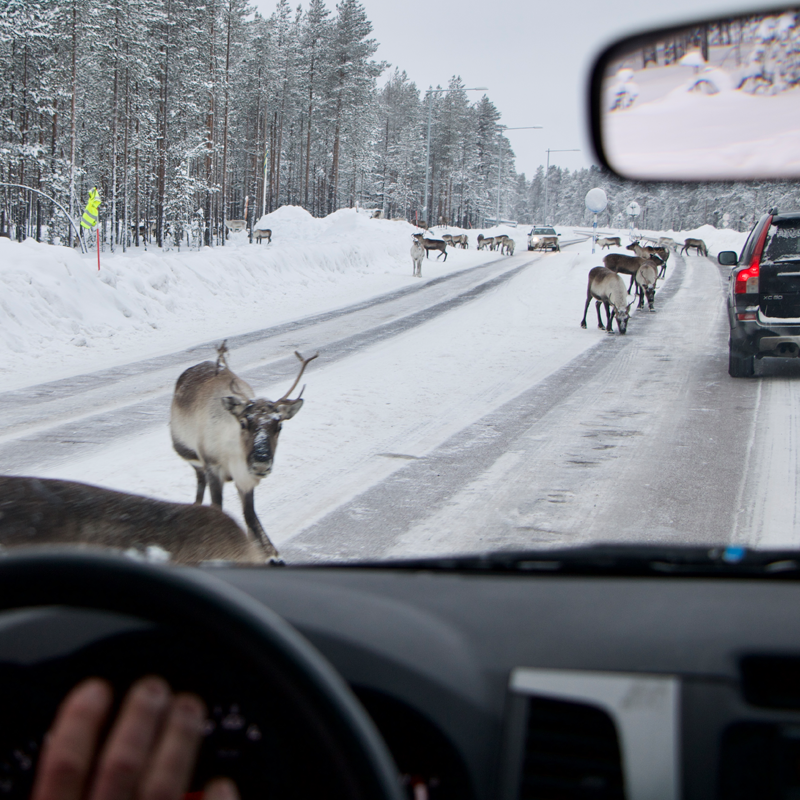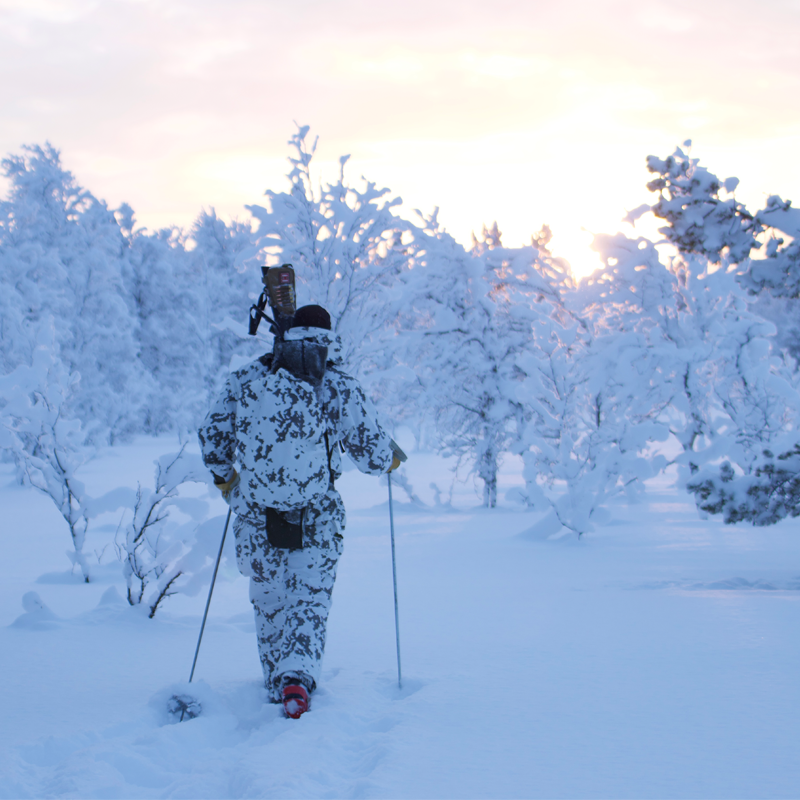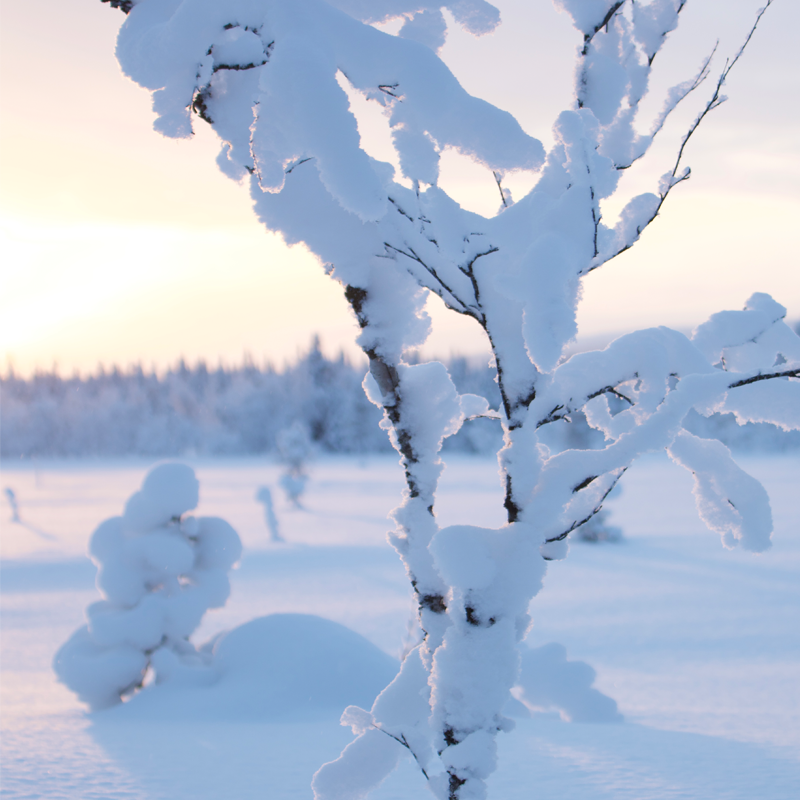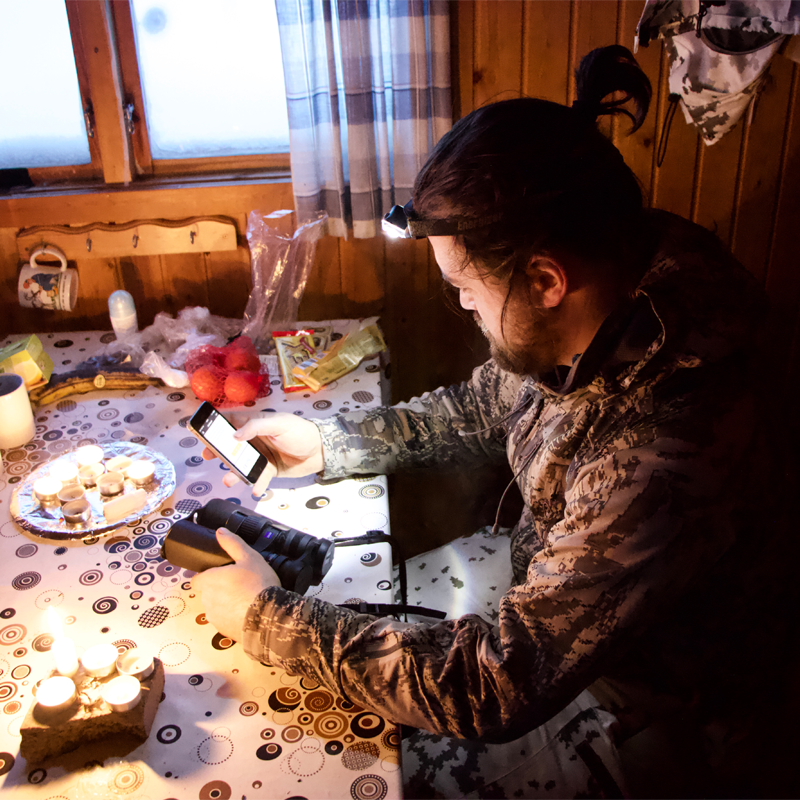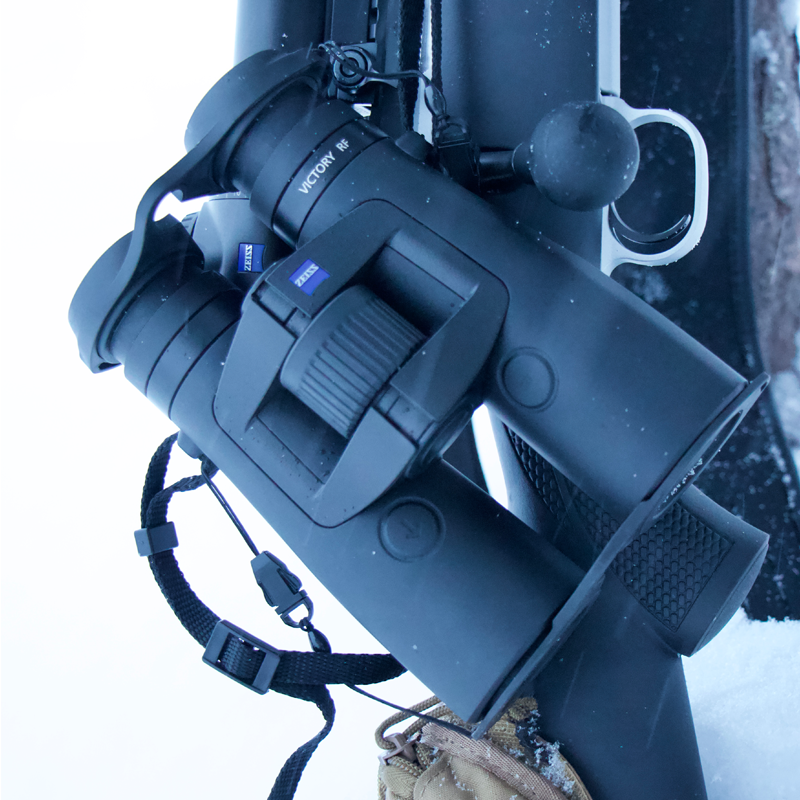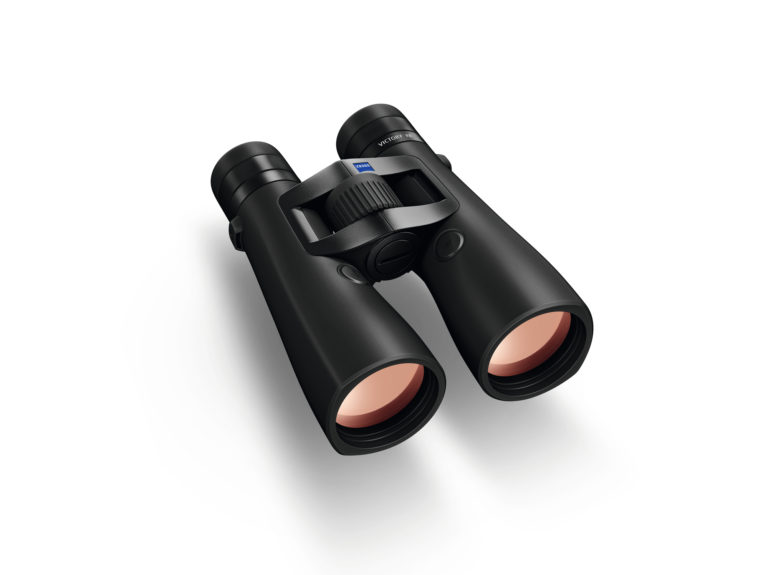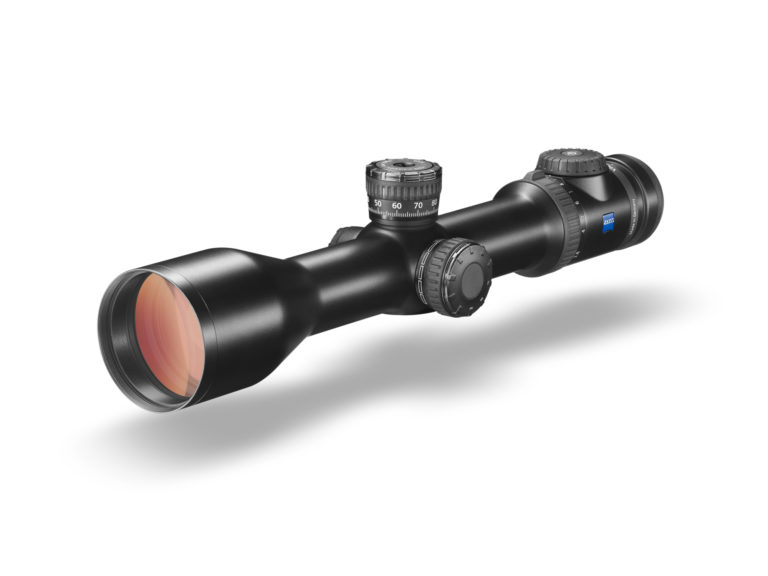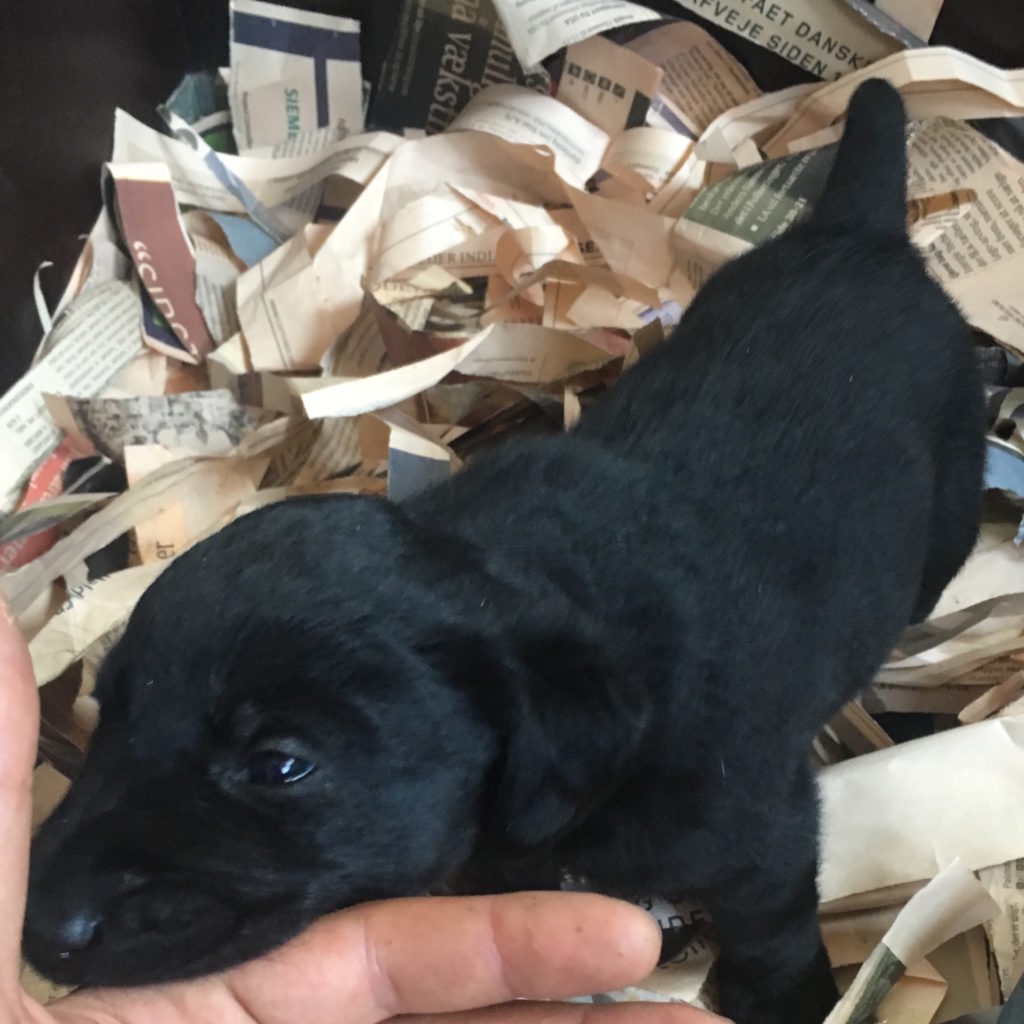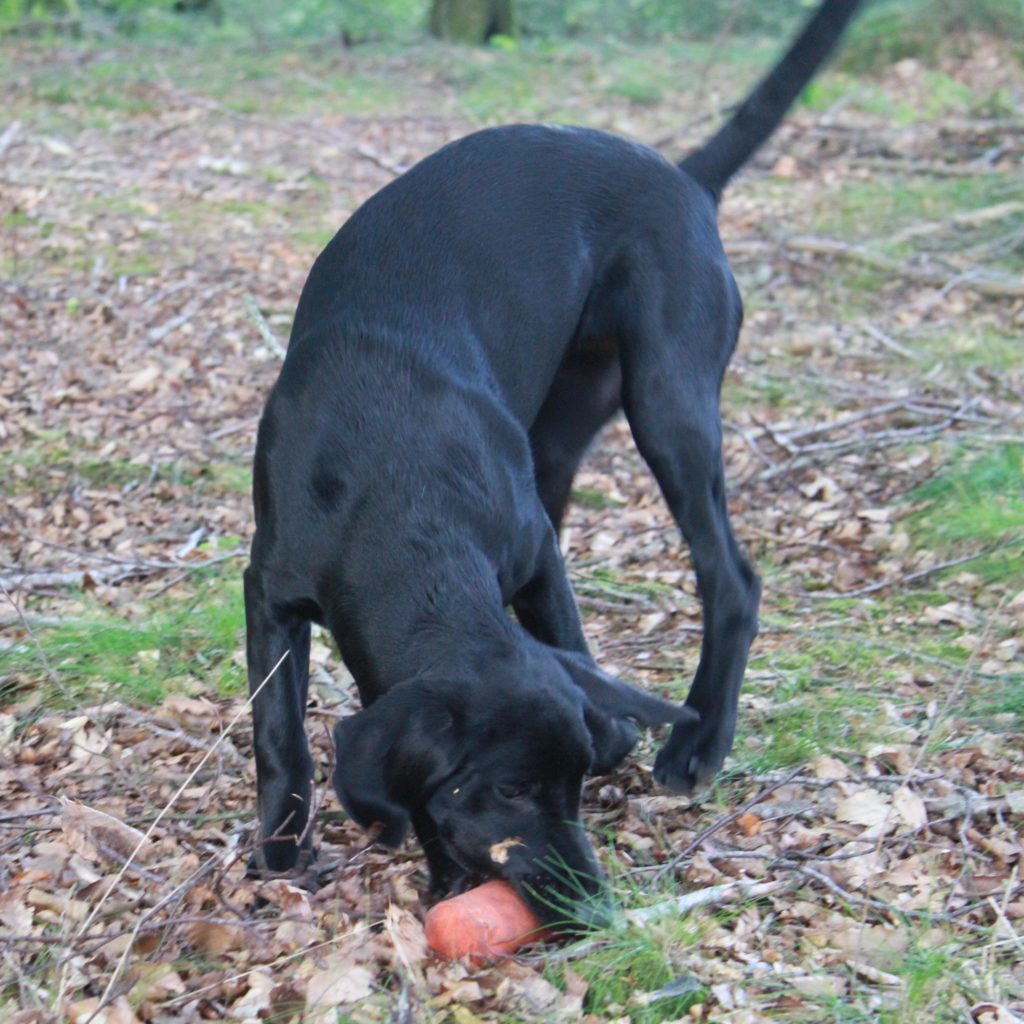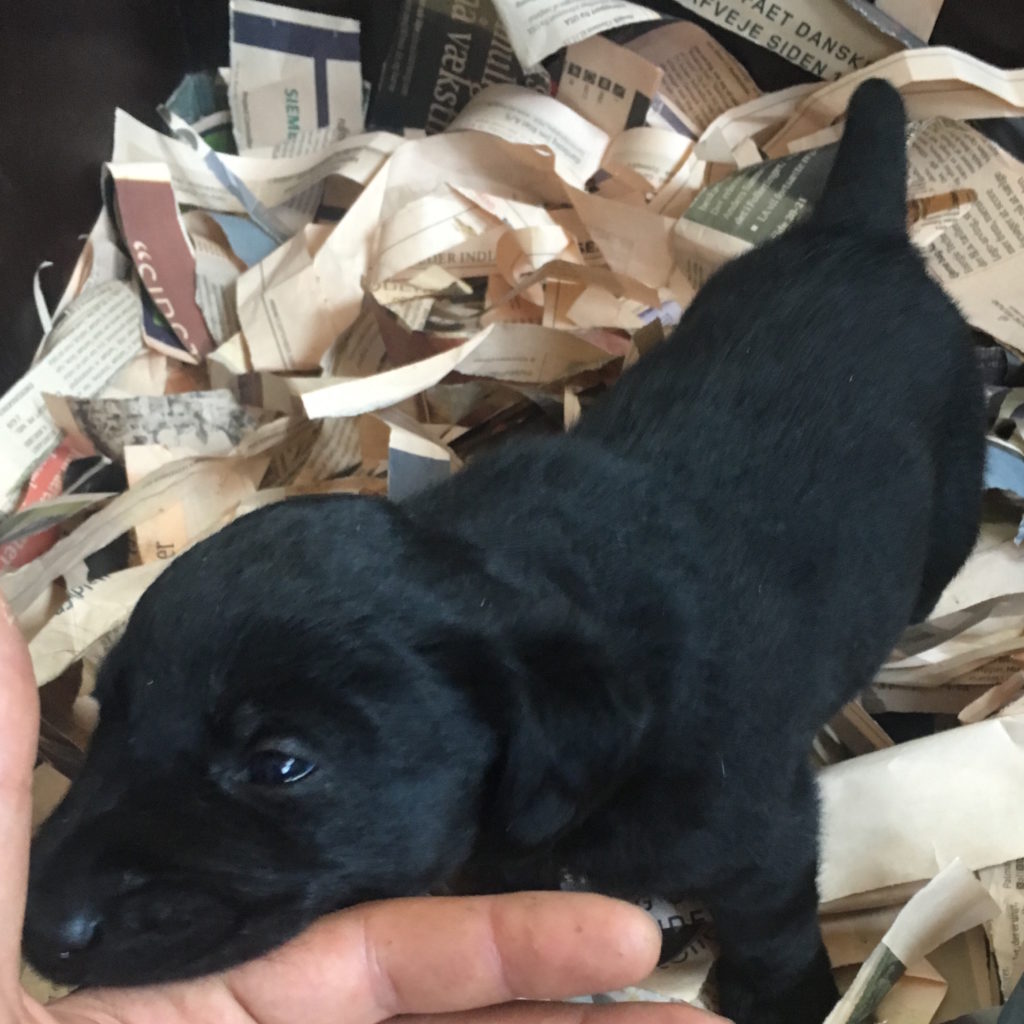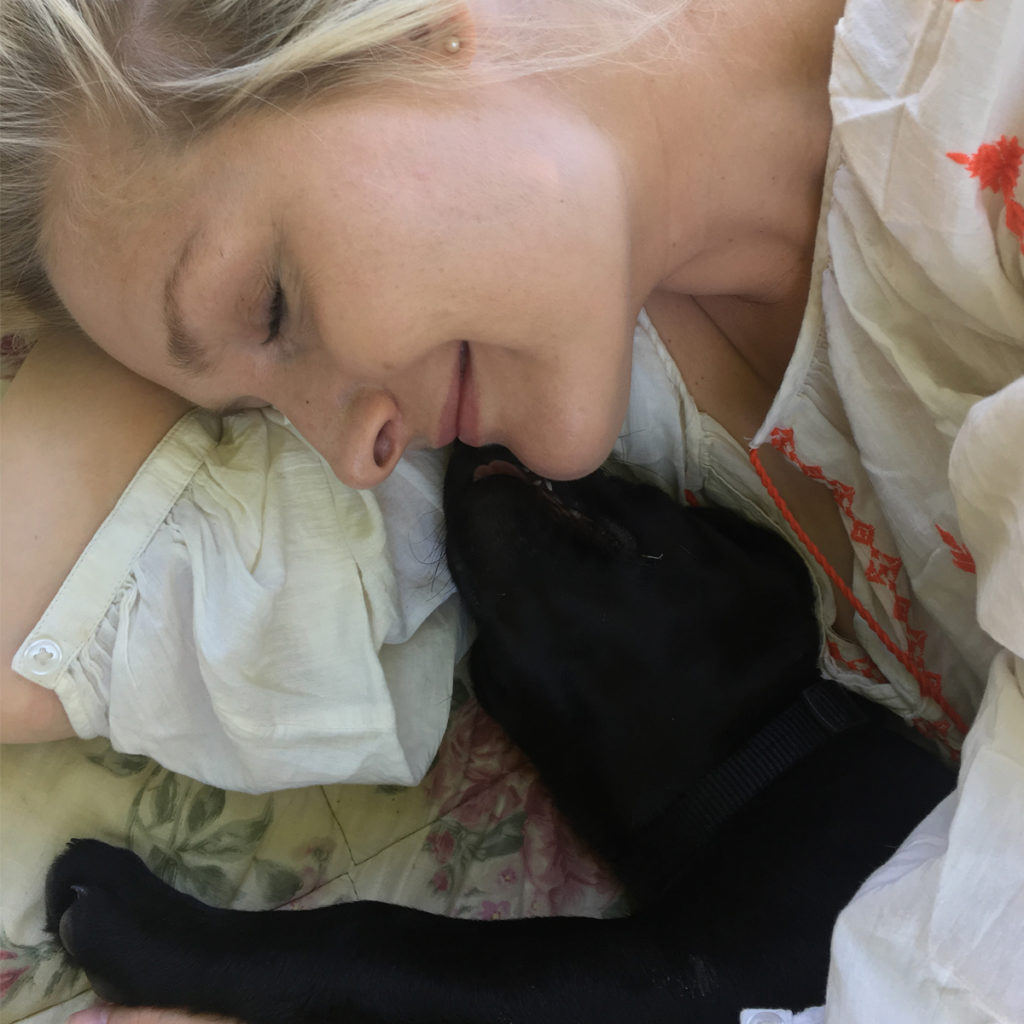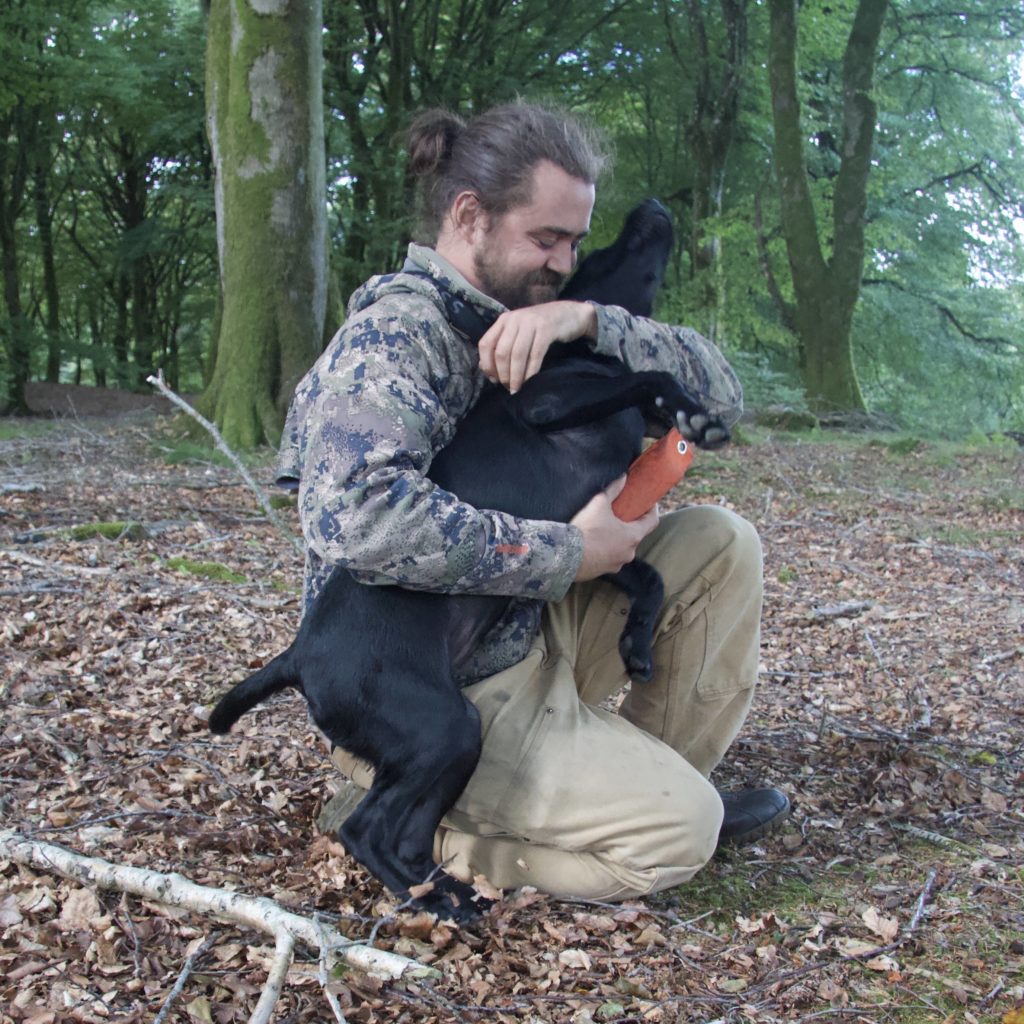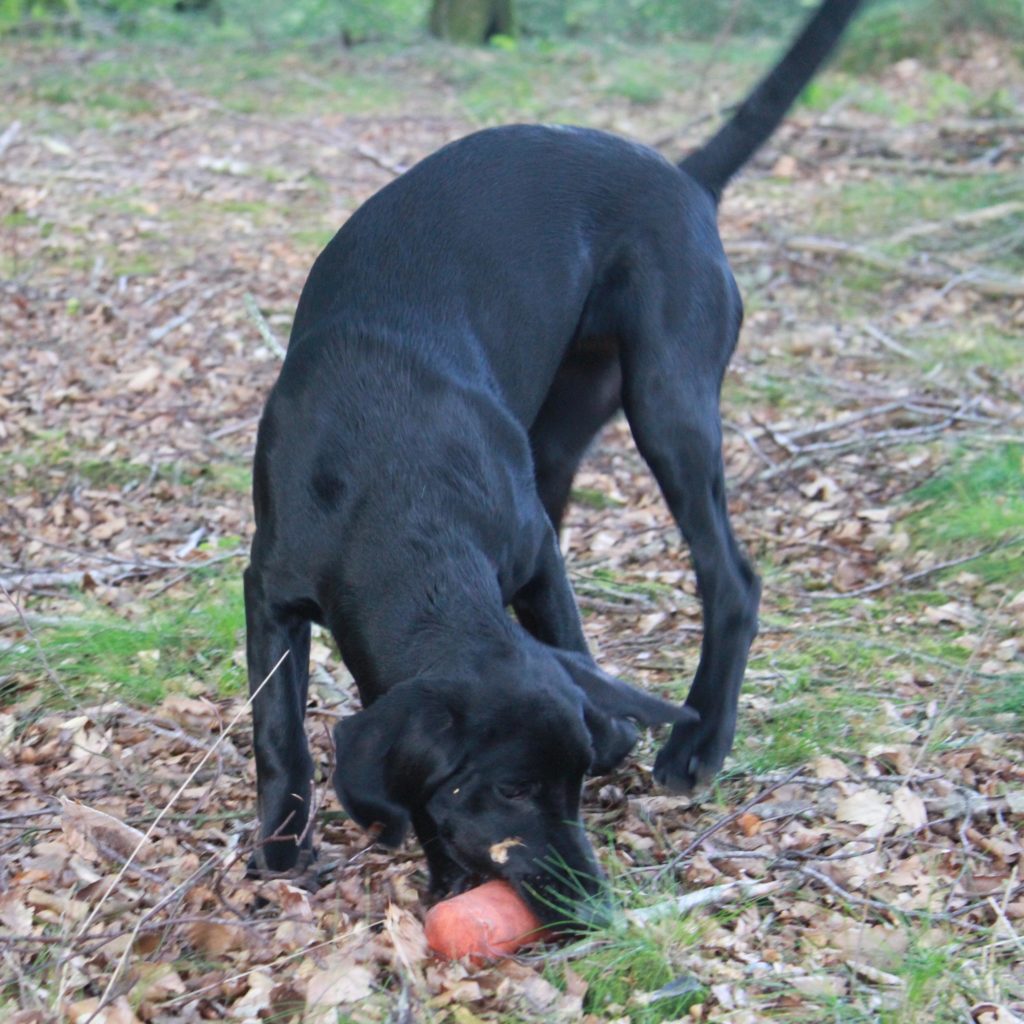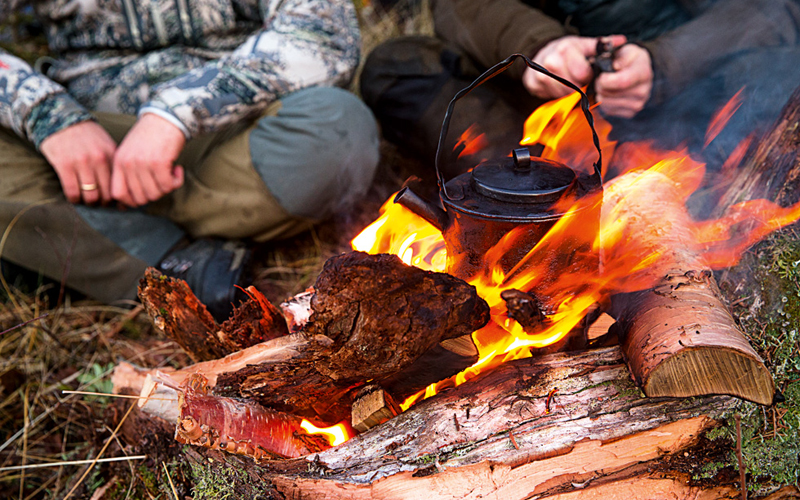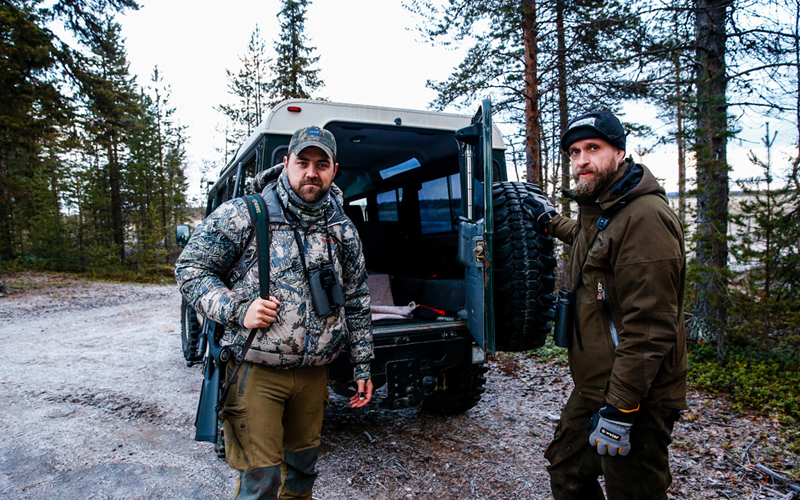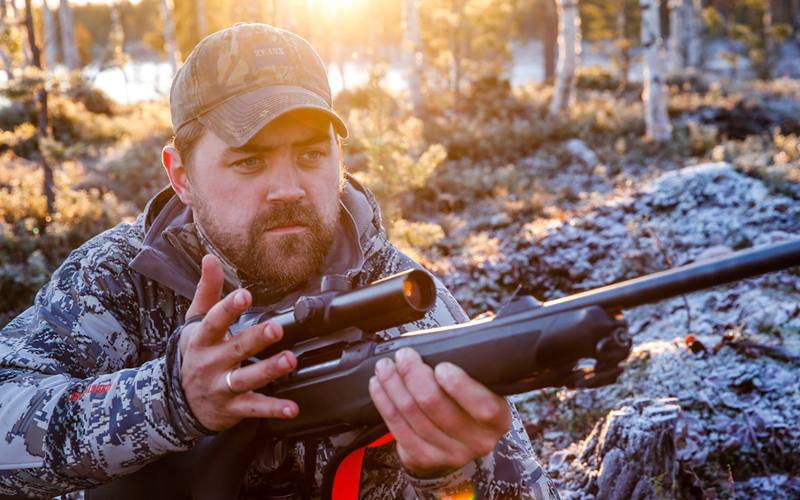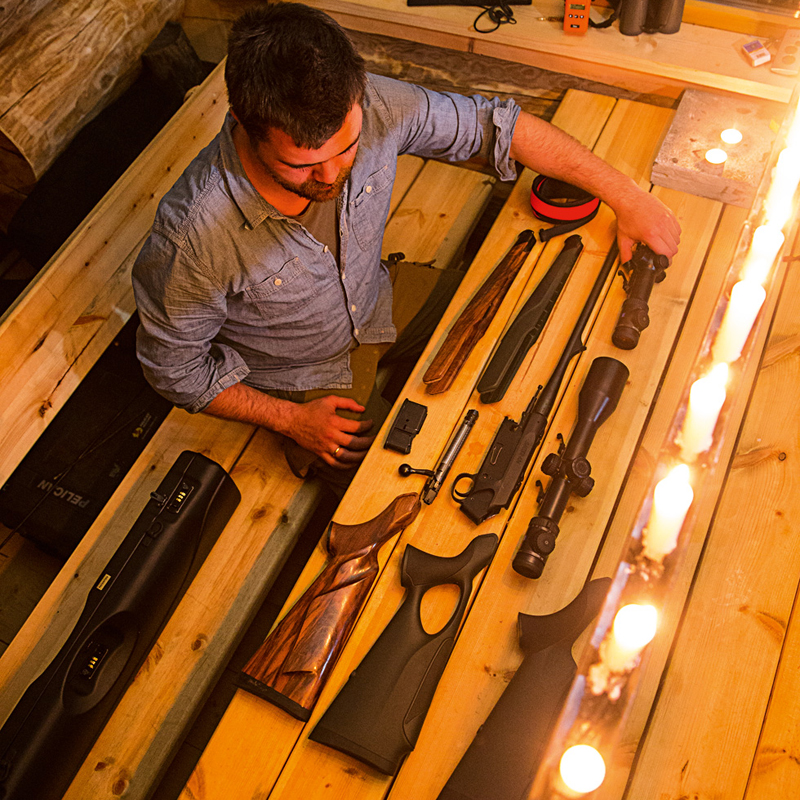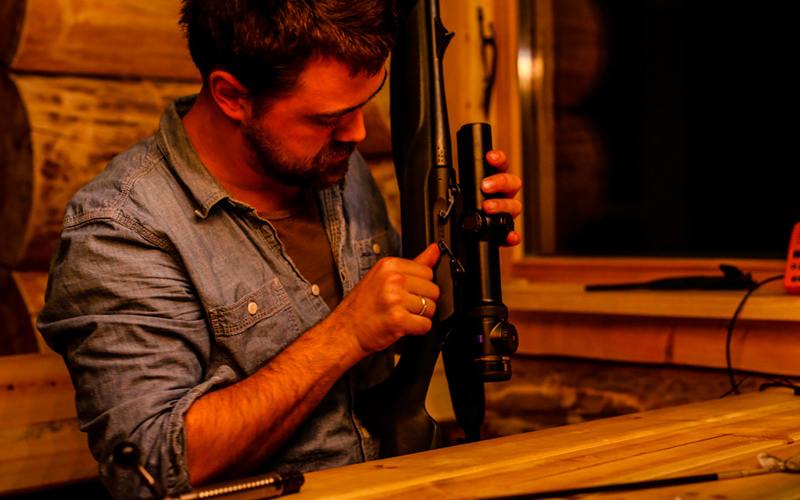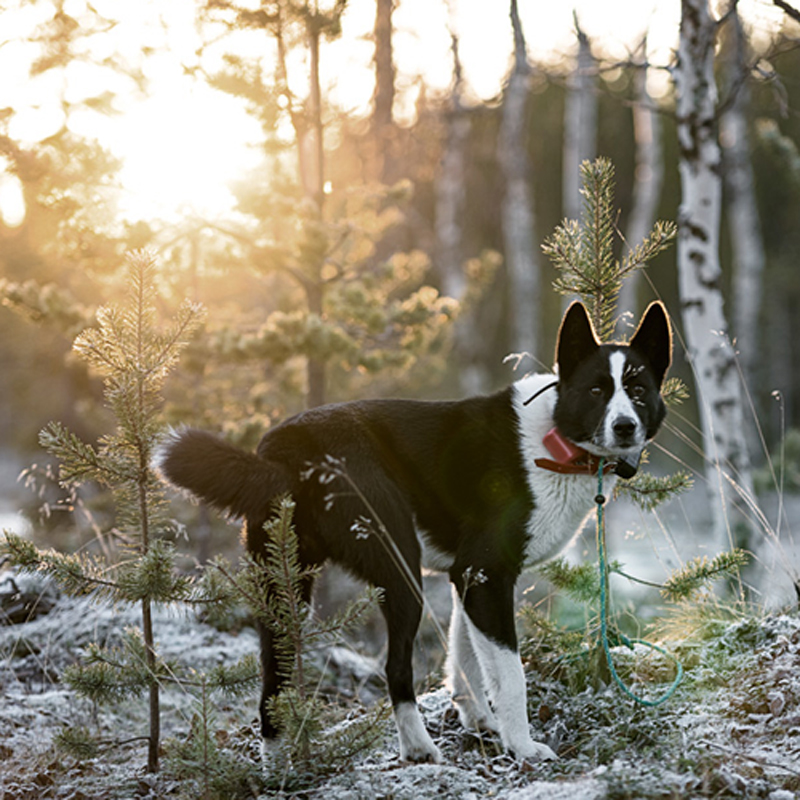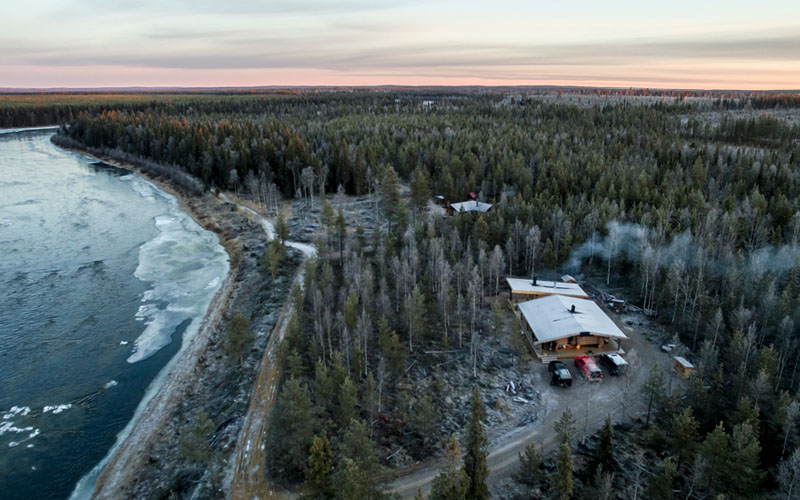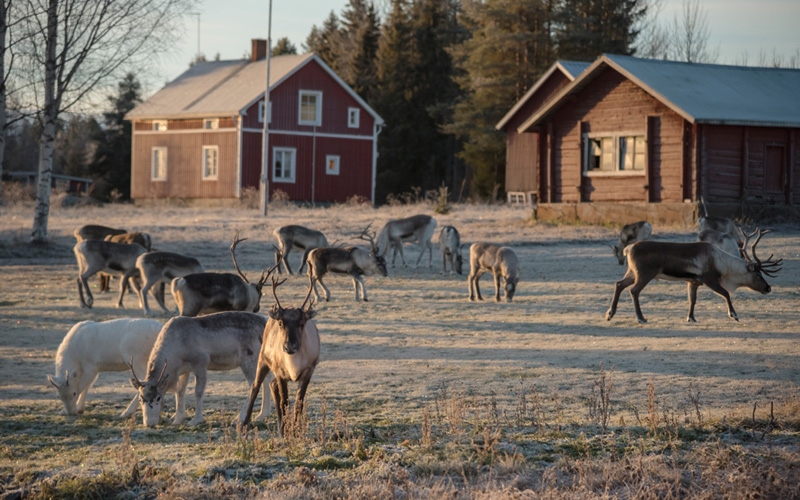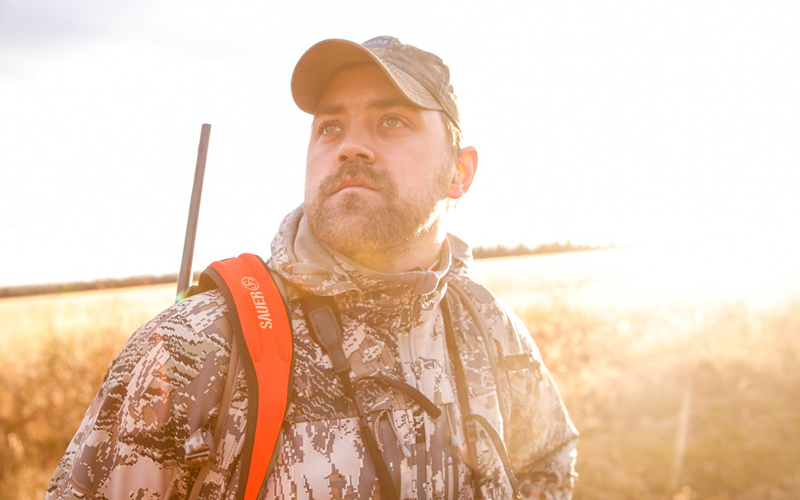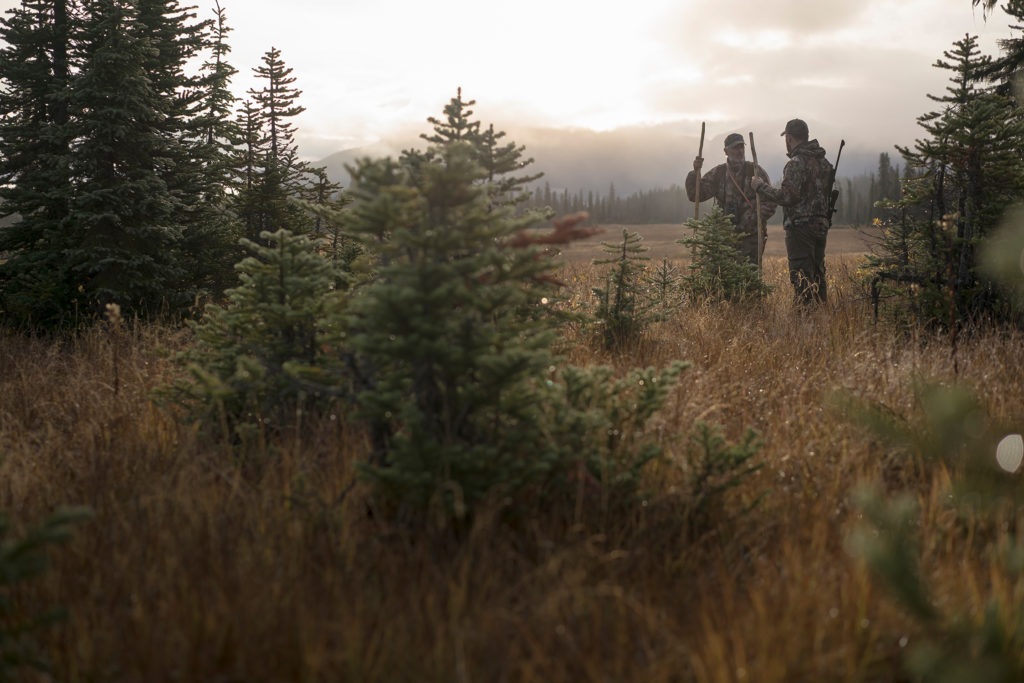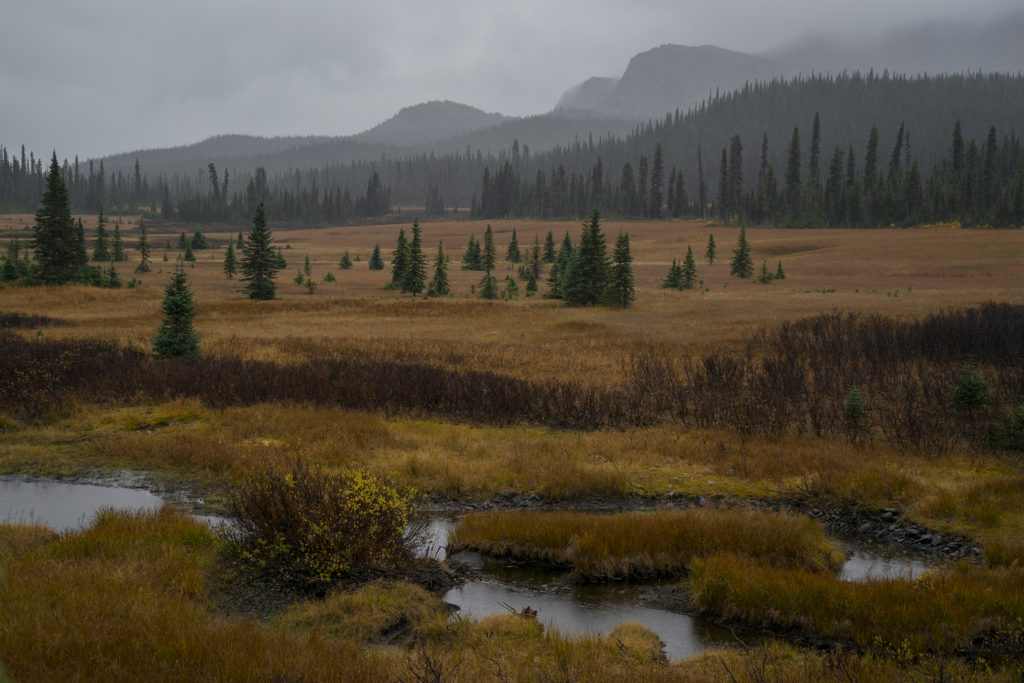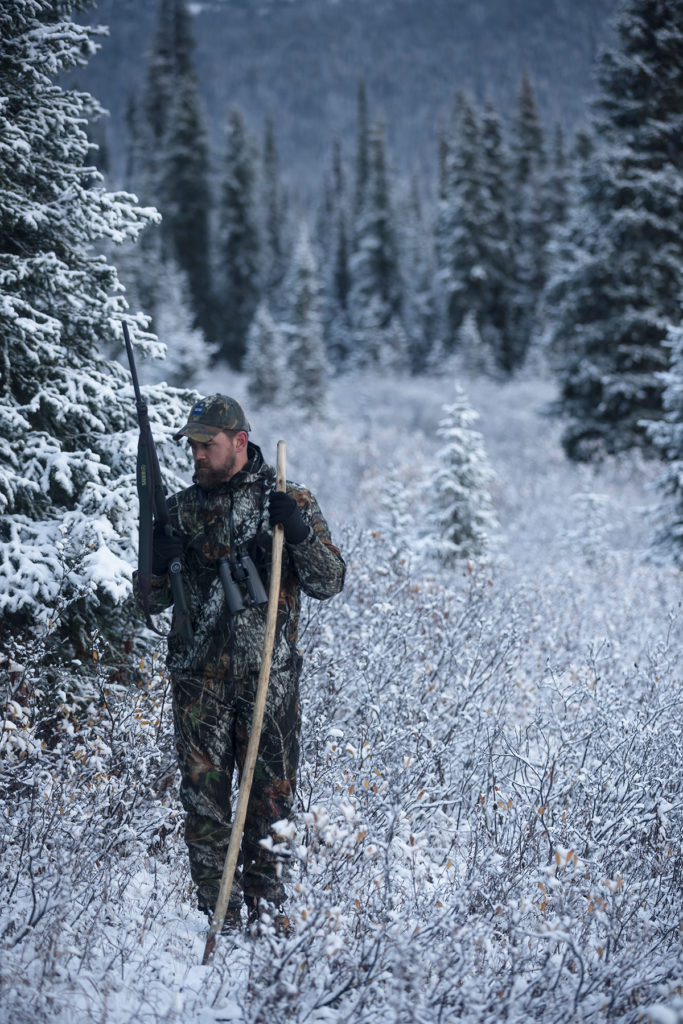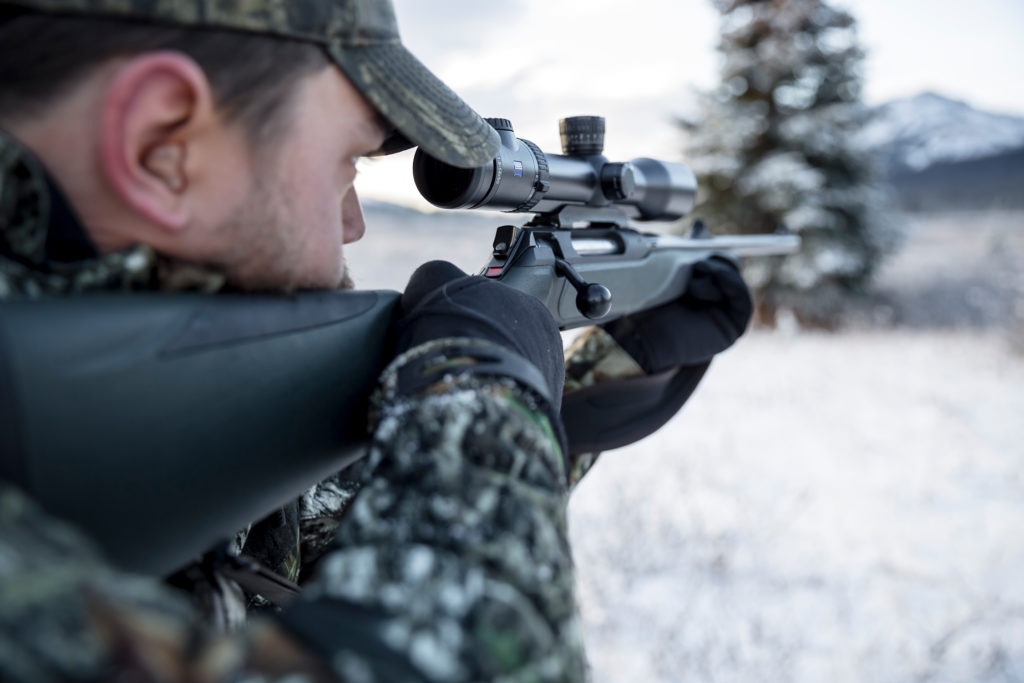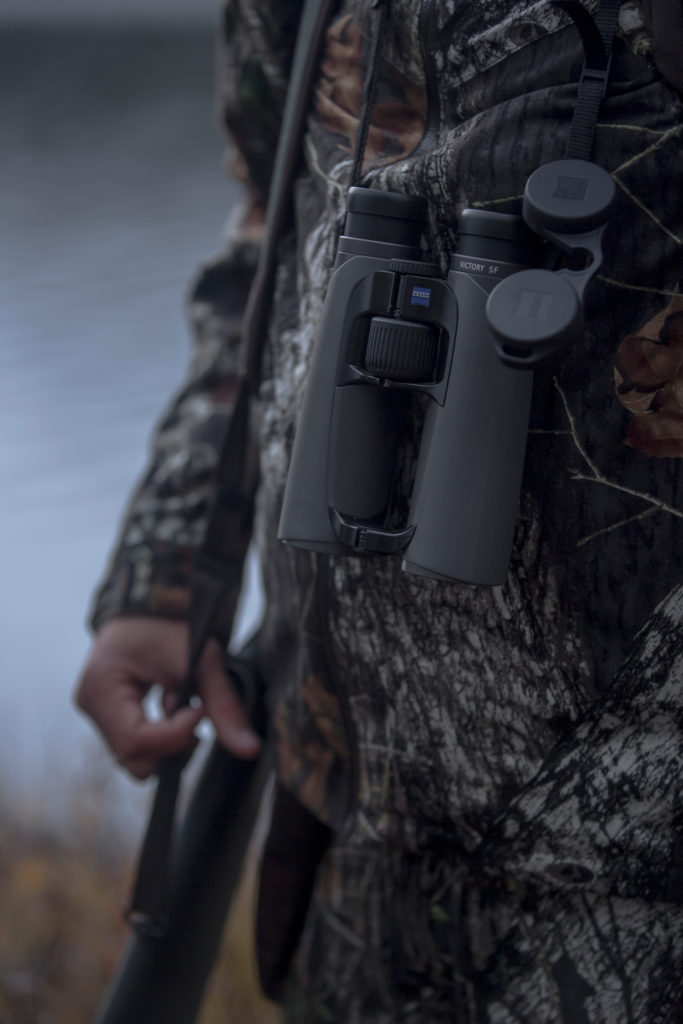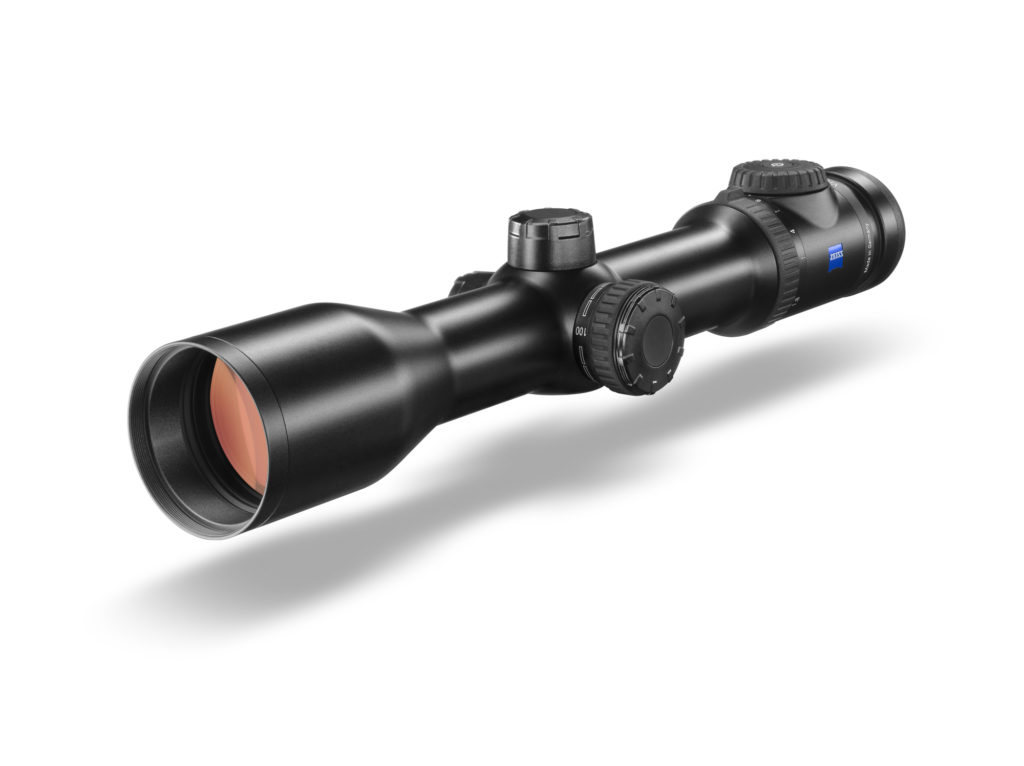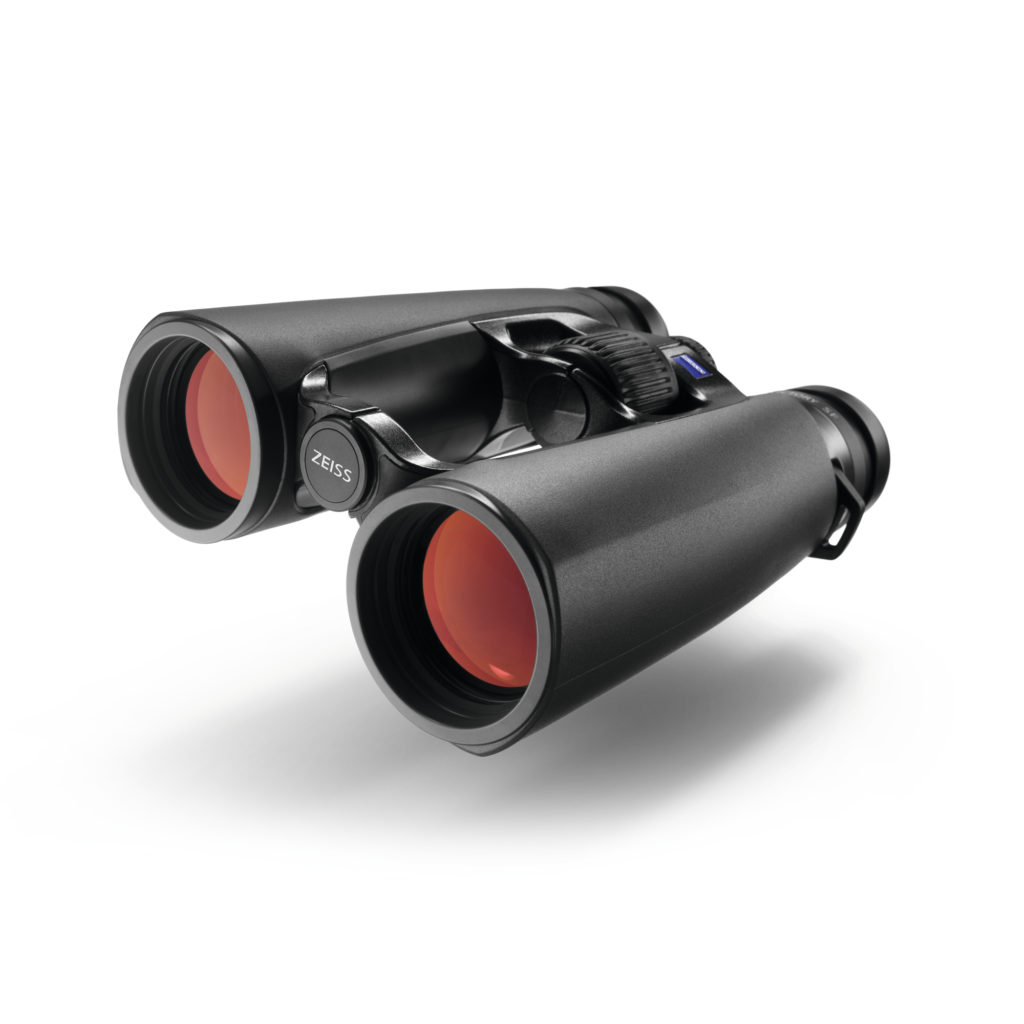When it all comes together
Since its introduction to New Zealand in 1904, the Himalayan goat has fared very well in the rough and mountainous region around Mount Cook, and has now spread to a wide range of mountain tops and valleys of the Southern alps.
Its thick coat makes it impervious to the harsh climate of the mountains, and its ability to scale almost vertical mountain sides means that you will often find them in places, only reachable by helicopter or arduous hikes up the steep mountain sides. This makes the thar a great and challenging specie to hunt.
Knowing this full well, I was almost shocked when I found myself on a mountain side, looking at a beautiful bull thar trough my V8. We had just started out that morning, on what I expected to be a long and hard ordeal, crawling over sharp rocks and loose shale, trying to get into position of the wary thar. But suddenly, like a roebuck walking into the meadow in a far off European forrest, the big bull came up over the ridge towards us.
As he jumped from one rock to the other, it was clear from his limp that he had probably been injured – maybe from fighting other bulls for domination of the heard. I got a closer look at him trough the Victory SF.
After a couple of tough weeks hunting red deer with little succes, here I was, looking at a great thar coming towards us after what had seemed like a quick morning stroll on the mountain. Eager not to loose this opportunity, I had dropped down in a good steady rest on my backpack. And now I was waiting for the broadside shot.
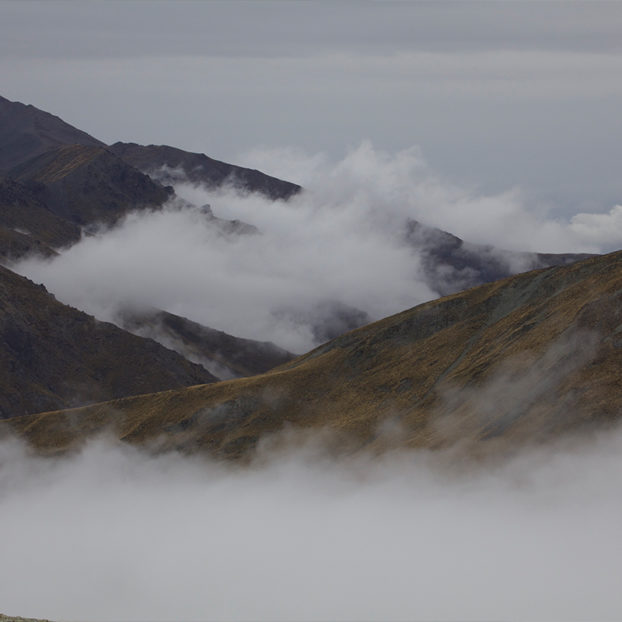
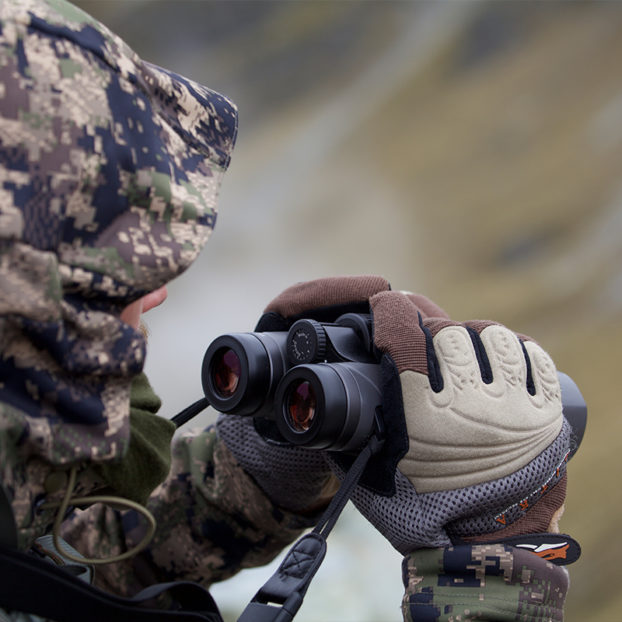
When you get an opportunity like that, there is always the risk that you are being over confident and that something goes wrong in the last second.
DAVID CARSTEN PEDERSEN
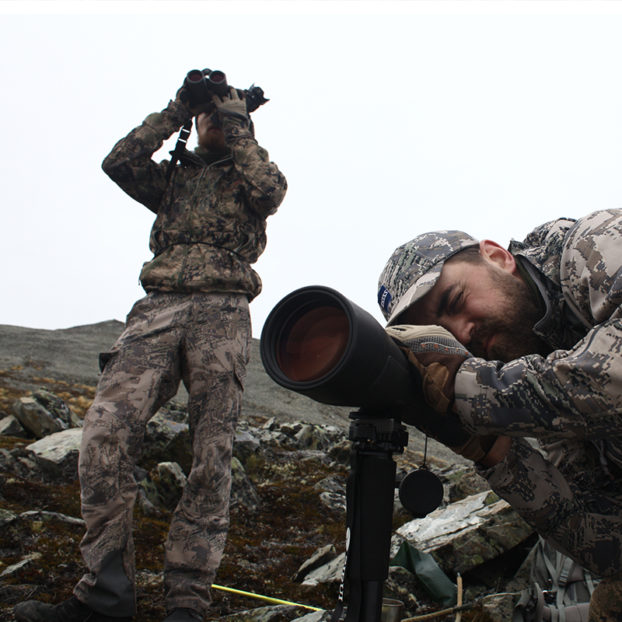

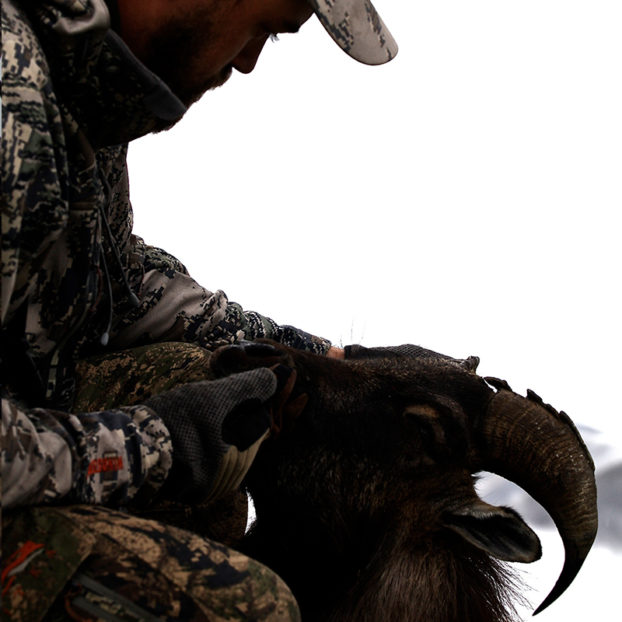
Moving closer, the bull suddenly stopped and turned his head to look straight at us. I dont know if he caught our wind. Or if his many years on the mountain had just taught him to be wary of everything. Knowing the range was good and not willing to wait and see if he would stand or run, I gently squeezed the trigger on the Sauer 404.
The light trigger broke like glas and even with the recoil of the 300 win mag, I could clearly see the shot land right behind the front leg of the big animal. As the bullet hit, he made a great leap forward, sprinting down the mountain side. And then he was gone. It was as if the long hard grass had swallowed him completely. The only thing left to testify what had happened was bullet casing on the ground and the sound of the shot, still echoing trough the valley.
“That was crazy, mate!” It was clear that my hunting buddy Ulrik was as happy as I. He had been hunting thar before and knew full well that what we had just experienced was luckier than we probably deserved. But as we went to look for the thar, we talked about all the parts that had to come together to make this happen. And the more we talked, the more agreed that luck was only a small part of it. We had done our homework and found an excellent guide who had showed us an area with plenty of thar. We had been training for weeks in the mountains and forests of the South Island, getting fit enough to move around in the shale without problems. We had brought gear that was made for the harsh mountains: optics making even the smallest details stand out, a rifle that could reach as far as we would ever need, and camouflage that made us disappear – even to the sharp eyes of the thar. It was this combination of research, preparation and the right gear that had made the hunt seem easy. The lucky part was being at the right place at the right time.
We found the thar less than a hundred meters from where he had disappeared. His beautiful head rested in the grass and his fur smelled of mountains and fog. “Now comes the hard part,” said Ulrik with a big grin. “You shoot him – you carry him” he said, smiling from ear to ear. Sometimes there is only the hard way.
HOW TO HUNT IN NEW ZEALAND
Hunting in New Zealand is a great experience for any hunter with an adventurous heart. As one of the few places in the world, it’s possible for foreign hunters to hunt on public land without a guide. Obtaining a firearms license and a hunting permit is easy and can be applied for online at the department of conservation’s home page, or at a local police station or DOC office. Be advised that hunting on public land can be physically challenging, and if you don’t have the proper experience and preparation, it can also be quite dangerous. Hiring a local guide is an easy and recommendable option for foreign hunters who want to make the best of their time in New Zealand. Spending time with the locals and learning from the vast experience and skills of the Kiwis is often as much a part of the experience as the hunt itself. There is also the option of hunting on large private areas. Here, the physical challenge will often be be less grueling, but the hunt can still present a good challenge for hunters looking for a great experience in New Zealand.
Equipment used
Long-rage shooting
A Hunting Trip for Capercaillie
In the Heart of the Winter.
A hunting trip for capercaillie to the far north of Scandinavia turns into a journey of self-discovery for ZEISS hunting ambassador David Carsten Pedersen.
“It’s been really good to hunt with you.” The statement came from one of the greatest hunters, I have ever met. The man was Tommy Holmberg, the legendary hunting guide from Swedish Lapland, who had once taken a man-eating bear. We were both lounging besides a small wood stove, tired after some hard and successful days of hunting moose. In the few days we had hunted together, we had become great friends, and his praise meant a great deal more to me, than I think he knew. “But you have to come back for a capercaillie hunt in the winter. That is really something really special. That is where you really get to experience the spirit of Swedish Lapland.” Knowing that I had to go back the next day, I was all ears and wide eyes for more adventures in the future.
“It’s not an easy hunt though.” He said in the long low dialect of the Northern Swedes. “You hunt on wooden skies. Shoot very far. And it can get really cold”. He said this with the same matter-of-factness in his voice, as he talked about everything else. In Lapland, they don’t spend unnecessary amounts of words on anything. So, if Tommy said it was a good hunt, then that’s what it was. And of course, I told him I would be back. At that point Tommy could have told me to crawl inside a bear den and hug a sleeping sow, and I would have done it with a smile. All I could dream about was coming back to this place above the arctic circle, to hunt the royal bird of the woods: The Swedish capercaillie.
It’s is going to be really cold, buddy. You better dial in the right temperatures.
David Carsten Pedersen
A few years later I found myself at the shooting range with my good friend Nikolaj. We were going to visit Tommy in Lapland to hunt capercaillie. And we were expecting some very long shots under extreme temperatures.
Right now, we were discussing the effect that temperatures have on the ballistics of the bullet. “The bullet drops about 0,3 TS for every 20 degrees difference, give and take, so we better take that into consideration” Nikolaj was telling me, while we were setting up the ASW+ for the coming hunt. “And it looks like it’s going to be bloody cold, mate” he said with a smile on his face. The weather forecast predicted, that it would drop to -20 during the day. This would mean at least 30 degrees difference to the relative warm conditions, we were experiencing at the range.
But we had both been to Lapland before, and we were accustomed to hunting under hard conditions. Packing wool and multiple layers of clothes, we were not that worried, that we could keep warm. And after confirming the ballistics in the ZEISS Hunting App, we felt confident, that any shot we were presented with, would be possible to take, even on such a relatively small target as the vitals of a capercaillie presents at long range. The only thing left now was to pack all our stuff and ready for 4 days above the arctic circle.
Welcome back to swedish Lapland, my friends!
The small bald man with the long beard and the big clothes greeted us with a hug, that would fit a bear, the moment we stepped out into the airport in Lulleå. With shining eyes and a broad grin, Tommy Holmberg was every bit as grand, as I remembered him the last time I visited Swedish Lapland. “I don’t know if you checked the weather forecast, boys. But it’s going to be really cold”. He continued in a tone that I hadn’t heard before. Something was up. When we pulled out of the airport in his big Highlux, we drove straight into a traffic jam. A herd of reindeer were blocking the road in front of us. Every car slowed down a crawl, while passing the docile animals.
“I really hope it’s only going to be around -20 C°” Tommy said, in the same voice as before. “But it looks like it’s going to be a lot colder than that. Maybe even -30. We will be lucky if we get one or two birds. But I have to tell you, that we might not see any birds at all”. Driving towards our destination on the frozen highway, we talked a bit about this.
If it was too cold, the birds would not leave their dens to feed in the treetops, but stay under the snow, preserving heat and waiting for warmer days. The only way to spot them was to look for tracks in the snow, breathing holes and middens, and then try to flush them from their burrows. It looked like it would be a couple of hard days on skies. Sitting in the warm car, we had no idea just how hard it would actually get.
Looking for birds in a freezer
We were skiing as quietly as we could trough the frozen landscape. After almost a day on the long wooden skies, finally we had spotted a capercaillie midden under the snow, and tracks of the wings where it had taken to the sky. Now we were trying to find out where it had landed. And maybe even get a shot.
If you haven’t tried hunting capercaillie before, the technique is actually quite simple. You put on some very long wooden skies, with high tips that cuts through the icy top layer on the snow. Then you stalk through the forest, bogs and hills trying to spot the birds when they feed on pine needles. You only hunt for males, spending a lot of time glassing the tree line for their big black silhouettes. When you spot one, you try to stalk into range, making sure the birds don’t see you. The shot is often taken from a lying position in the snow, at ranges from 200 meters and up. This all sounds pretty simple. Until you have to do it in real life.
Unless you are a native to northern Scandinavia, chances are that you won’t have a lot of experience with the ultra-long wooden cross-country skies of the Sami. Combine this with the fact that there is about 1,5 meter powder snow everywhere and you have to cross through thick forest hills and rivers, you start to get an idea of how physical this hunt really is. And then, there is the speed. In order to get a good day’s hunt out of the short time span of the winter daylight, you have to ski hard and fast. After the first 200 meters you start sweating heavily. If you don’t regulate your temperature you will start getting wet, and risk getting hypothermia. Taking off layers of clothes means you have to keep up the pace or risk getting cold again. Taking a rest means putting on clothes. Breaking a binding or even worse, breaking a leg, can result in death. In short, it’s not as easy as it sounds. But we were having a great time.
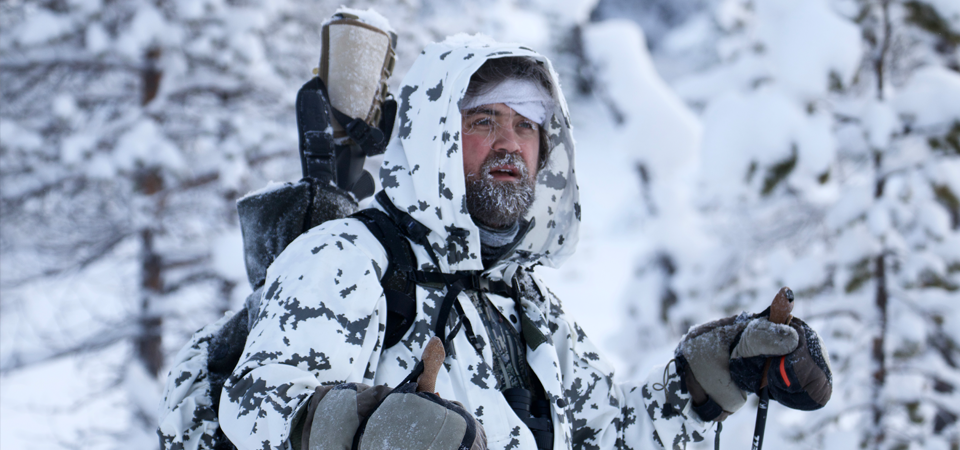
“I think he might have flown that way. If you go left around the bog, I will go right. Signal me if you see something” Tommy proclaimed with the same certainty, that he had been guiding us all day. If there ever was a bird in this vast frozen landscape, he would surely find it. Trusting him completely, Nikolai and glided away through the trees, breaking the surface with a swish. The sun was already going down again, after only a few cold hours in the sky. Stopping later for a snack of nuts and chocolate, we checked our thermometers. It had dropped to – 32. And besides the midden, we had not seen any sign of life.
“I have never been in a place this dead.” I thought to myself as we scanned another tree line, trying to force a bird into existence. It’s as if we are on another planet, a beautiful and dead planet with organic silica in the shape of trees, covered with a thick blanket of snow. Nothing moved. Not even the wind. Everything was frozen and quiet. The only thing of warmth in this gigantic deep freezer, was three men pushing through the snow, into the mountains, towards a bird that might never be there.
When the sun went down on the second day the temperature had dropped to -38. We had been skiing hard the whole day, and now we were sitting on our skies in the snow, eating our meal of hot reindeer soup, and cherishing our big puffy jackets, before heading back on the skies towards the huts. We had not seen anything all day. Not a single living animal. Only the enormous white wasteland of ice and snow. We had at least 7 kilometers off skiing before we were home. This time, the sun would be down and we would be skiing under the lights of our headlamps.
The mood was good, but the temperature was starting to get to me. It was almost physical. A hard cold that stung in the nose when you breathed and sapped the warmth out of everything. Our beards were frozen and we had ice in our eyelashes. Hugging my warm mug of soup, I couldn’t blame the birds for hiding underneath the snow. Anything that moved outside would die. Even Tommy was obviously affected by the cold. We needed to get back on the skies and make our way home.
And that’s when things started to get really serious. It started out with my toes. I’ve always had bad circulation in my feet. So, I’m used to not having any feeling in my toes. But no matter what I did, they could get warm.
I didn’t think about it at first. It just started as a creeping coldness that seeped up through my feet and into my body. Little by little, the cold was everywhere. I couldn’t focus on anything else. It was everywhere. In my mind I knew that I was going home. I just had to keep my head and find a place inside where I could keep warm. And I would be home. So that’s what I did. In the darkness off the winter night, with the moon shinning cold white light over the frozen forest, I reached inside and found a bubble of warmth. It felt as if I left my body and saw myself from the outside. Around me was the feeling of the forest, the hills and the lakes. I knew, I was cold all the way to my bones. But somehow, I was warm. And laughing.

The heart of winter
When we came back to the hut, I almost stumbled through the door. The fire was hot and the food was warm. But no matter what I did, my feet felt like icicles. All my toes where white and the tips of one had started to go blue.
“You are not going out today my friend”, Tommy said in a serious voice. During the night, my toe had started to turn blue. There was no way getting around it. It had frostbite. “You will loose your toe, if you go out” he repeated. Dead-serious. When a man like Tommy tells you not to take risks, you don’t. It’s as simple as that. But as sad as I was to see Nikolai and Tommy leave for another day on the skies, I had a strange smile on my face.
I found something in the darkness the night before. Something that came to me, while I was in my hypothermia-induced trance. Something that was still with me, as I saw them grow ever smaller on their way over the ice. It was the impossible sensation of life, that insists on living, even under the harshest conditions. It was right there. In the mountains and the trees and the sky. What I had found in the frozen tundra of the north was the warmth of life, living in the stillness between a heartbeat, waiting patiently for the spring to thaw its vanes and let life flow back into its limbs. At that moment I felt humbled and blessed to be alive. And as I turned to walk back inside the warm cabin, I couldn’t wait to go back to Lapland again.
Equipment used
About Hounds Part 3: Puppy Love
David Carsten Pedersen about raising his hunting dog “Mille”
She treats every human being as a potential friend and petting machine.
David Carsten Pedersen
“Can we pet your…”. Yes of course you can. She likes it. And it makes her less afraid of the big city with all its noises. Actually I though she would be more stressed out about living in the concrete jungle. I know I am. I hunger for the forest and the open spaces. But Mille seems to be right at home in the big city. She’s not afraid of sirenes. She doesn’t stress about the cars. She treats every human being as a potential friend and petting machine. Because thats how she experiences life. And through her I get to experience people in the same way.
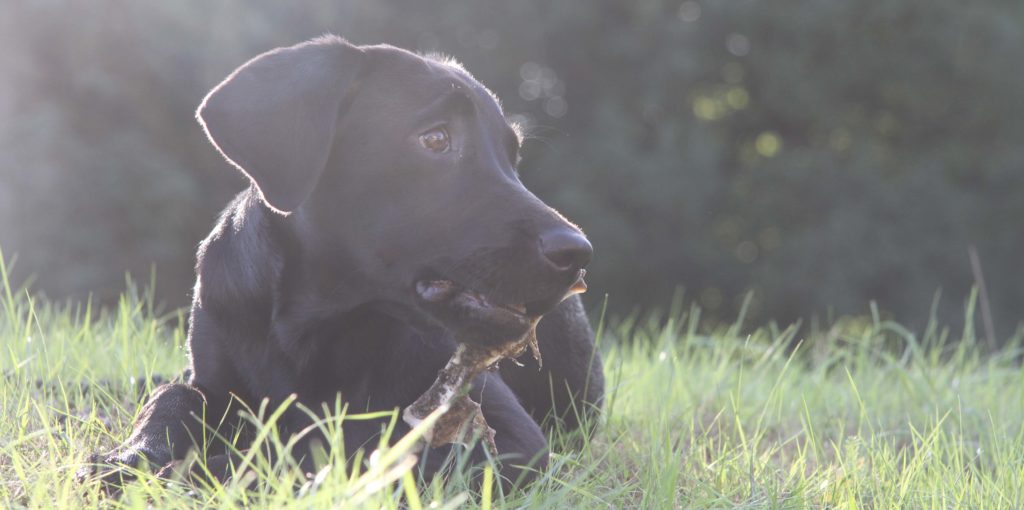
Instead I get to enjoy the conversations. When you own a dog in the city, you quickly find out, just how many people actually miss having a dog. They all tell you about a dog they once had, the dog they left at home, or just their dream of having a dog one day. People seems to need to talk, almost as much as they need to pet puppies. So you share small stories. You enjoy each others company for a while and then you move on. And after a short walk, you end up little bit happier that the human race isn’t so bad after all. If you look at them through the eyes of a dog.
I had decided that this buck would be the first buck that the dog would try its teeth on.
David Carsten Pedersen
“Come dog” the big machine was rumbling like a sleeping bear. The dog was 9 weeks old. And she would have none of it. “Come Mille. I’ll show you something great”, fighting her urge to be with me and her fear of the big four wheeled motorcycle, she looked at me with disbelief “I’m NOT going on the thing” she implied with all her being. But I would have none of that. It picked her up gently, and put her on my lap. With one hand on the dog and one hand on the throttle, I nudged the big machine into action and gently rolled of with the dog looking up at me as if I was crazy. But I knew she would change her mind. I had something to show her.
30 minutes earlier I was standing at a tree line, looking at a small pricket buck, eating away all the foliage, less than 30 meters away. “Should have brought the bow” was the first thought that went to my head, but I had only had little time before the sun was down. Picking up my rifle instead I had stalked through the low light of the forest, happy as a boy scout. I quickly spotted a large horny owl chick, sitting in a tree less than 10 meters from me. It had to be its first time out of the nest, and it looked perplexed at me while I stalked further on through the darkening forest. The buck had been waiting for me in a clearing less than 50 meters from there. It was a small animal. A yearling that wouldn’t amount to much, and the perfect animal to take out of the gene pool. I knew I had to many roes. And that taking out this so there would be less competition for food in that area of the forest. I knew it was the right decision to take him.
I dropped the animal with one clean shot, laying it to rest under the spruce that it had beed nibbling on. I had decided that this buck would be the first buck that the dog would try its teeth on. A small buck for a small dog. It seamed right. I dragged the animal a bit towards the road and then I stopped, going back to pick up my future track dog.
Driving the ATV down to the buck took no time at all. But the puppy didn’t like it. At all. The growling machine, the bumping of the track, the strangeness of it all. But she stayed in her spot on her lap the whole way, judging me with her big puppy eyes: “This better be good dude”. I stopped the ATV where I had dragged the deer across the road and liftet the dog of my lap. “Mille” I said while clapping my breast – a signal we had been rehearsing every time we had to train. “Mille – search!” She instantly started searching the area. Up until now we had only done the search command on dog snacks, but she clearly knew what the game was all about. Puffing like a tiny steam engine she picked up the track like a magnet on steel and followed it on a straight line, right up to the deer in the bush. And then she stopped. Sniffed at the buck. She waited for my command. “Take him” I said. And she went straight for the neck. I let her have a bit rough and tumble with the deer for a minute or so, just to give her a sense of achievement. And then I loaded the deer onto the ATV, my ecstatic puppy jumping around like a kid on Christmas day. It only took one word before she jumped onto my lap again, riding proud all the way back, with the air of a lioness on a fresh kill.
About Hounds Part 2: Owning a Retriever
About Hounds Part 2: Owning a Retriever
David Carsten Pedersen about raising his hunting dog “Mille”
I’ve seen labradors swim half a kilometer to fetch a goose out of the freezing November ocean. I’ve seen them drag deer out of the thick bush that weight twice as much as the dog. And for the last month I’ve seen my puppy retrieve anything that wasn’t nailed down. She looks so proud when she brings you a sock, a shoe or a toy. And then she sits down wagging her tail and smiles. Yes. She smiles.

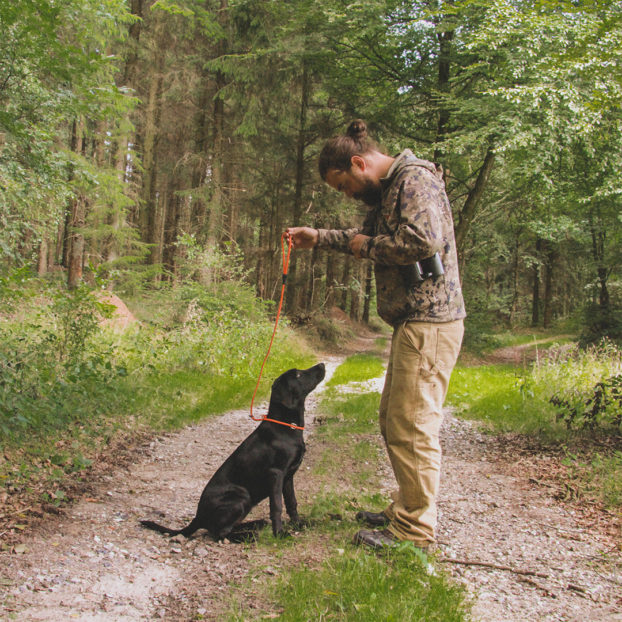
“I didn’t know, an animal could love you like that”, says my wife. She never had dogs, and grew up with two big black tomcats. They were very friendly and put up with a lot of stuff. But they were cats. A cat might like you. But a dog will love you more than it loves itself. And that’s why it keeps finding stuff that smells like you, parading around with it like a pheasant.
A cat might like you. But a dog will love you more than it loves itself.
David Carsten Pedersen
There is no such thing as a bad dog. But you get the dog you deserve. There are lots of people destroying a potentially great dog, by yelling at them because the dog didn’t do what they told them to do. But dogs don’t know what they are supposed to do. You have to teach them to do the right thing and praise them for their success.
It was Milles first day of “dog school”. We had been training for the last couple of weeks, but I always knew it would be a good idea to get some professional help. It turns out it was one of the best ideas I’ve had as a dog owner. When I was a child, no one went to a dog trainer. Hunters trained their own dogs and the results were varying. Some dogs were very good. A lot of dogs were not.
I think a lot of new dog owners think, that this is how it’s done. That training a dog on your own is the only way to do it, and that you don’t need help from a professional trainer. But think about it in the same way you think about shooting.
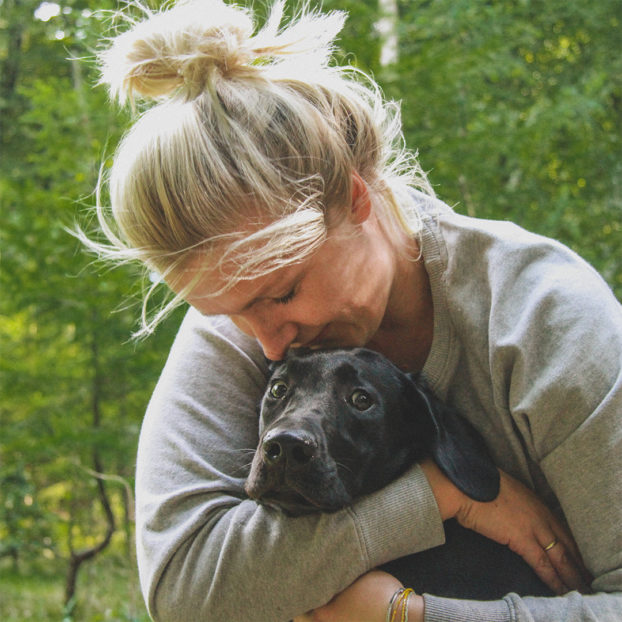
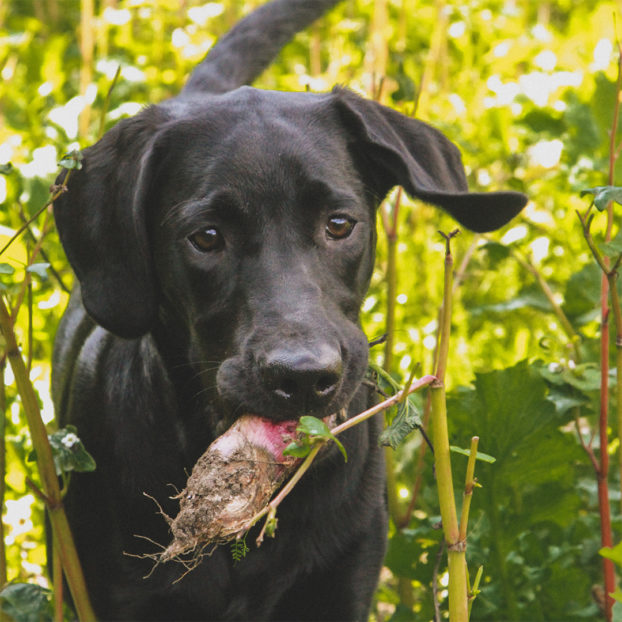
When I was a child, no one went to a dog trainer.
David Carsten Pedersen
Hunting with an experienced old timer will teach you a lot in a short time. Shooting long range is so much easier with a good spotter at your side. And busting clays is really not that hard… If you have a great coach. Teaching your dog is the same thing. It all starts with you.
“The dogs brain is basically a computer with everything installed. You just have to find the right button and start the right program. But it’s YOU that needs to learn how to do it. Starting everything at once will stress her out.
So start slow and have fun.” So we started slow, practicing the skill of sitting down and relaxing around other dogs. Then we started walking. And sitting down. Every time she does something, she gets a snack right way. “You need to look at your dog when you give her a command. It creates a bond and makes commands easier”. Looking at Mille is not a problem. She smiles with her eyes as if she tries to tell me: “don’t worry buddy – we’ll learn it in the end. I’ll help you”.
Year of the Dog – Part #1 “Difficult choices”
About Hounds Part 1: Difficult Choices
David Carsten Pedersen about raising his hunting dog “Mille”
But with the final breath of my parent’s last dog (a black lab named Fenja), the era of dogs had ended. And for more than 10 years we’ve had no dogs in my family. No pattering of paws on the floor. No wet noses to greet you good morning. No oily fur smell in the car after a long hard day in the field. Not having a dog wasn’t a conscious choice though. It just kind of happened. We kept telling ourselves that we lived lives where it wasn’t practical. Too much work. Too many travels. Not enough space. Not enough time. Most hunters, who live in the city, can probably relate. We live lives, that are not geared for dogs. Or so we tell ourselves. So we make up excuses. But none of them are good enough. Because we still need our dogs.
And this year, I finally decided to take the leap of faith and get the dog I always missed. This post is the first in a collection of short stories about me, my dog and all the things you learn when a puppy enters your life and you have to teach it to be the dog of your dreams. There will be moments of frustration. Of self doubt and struggle. There will be tales of beautiful women and the hardships of having a dog in a city, where everyone wants to pet your puppy. There will be adventures and action, and insights into having your dog on a radioshow. There might even be storys of puddles in the hallway. All in all – it will be a series of what it means to have a dog. And why your life will never be the same without it.
There is a saying in the danish hunting community: “No hunter is complete without a dog”.
David Carsten Pedersen
“This is her. This is Mille.”
My wife held the sleeping puppy in her lap like a mother cradling a baby. She was sitting in the hammock, hung between two large walnut trees, gently rocking the tiny dog, while she looked at it with all the warmth of a summers day.
We were visiting the breeder of our future dog, and we had to decide, which one of the 8 tiny Labrador puppies was going to be ours. We had visited many times before and had the pleasure of seeing the tiny fur balls grow up to be tumbling toddlers with over-sized ears, legs and paws.
Oh the paws. There is nothing as cute as the paws of a puppy. Ok maybe the eyes. Or the ears. Or… well everything is cute about a puppy. Thats their major survival mechanism. It just makes it extremely difficult for anyone to choose the RIGHT puppy.
Naturally I had studied all the books. I had asked all the experts for advice. I had even heard a few methods from the police on how to find the perfect search dog. “Don’t pick the runt or the bully”. “Roll a ball to see if they show interest”. “Don’t pick the one the breeder wants to sell _ pick the one he wants to keep”.
Well everything is cute about a puppy. That’s their major suvival mechanism.
The advice were many and varied. But they didn’t solve anything. First of all, we trusted the breeder completely. My father had known the man for more than 30 years, his family was amazing with the pups, and everything about the way his own working dogs behaved, showed that he knew exactly how to breed and train just the kind of dog we wanted. We even had first pick. He would choose his own after that. We also couldn’t tell which one was the “runt or the bully”. All the puppies were very keen, super-attentive and focussed. They all wanted to be petted and never shied away from human contact. All in all, there was no “bad puppy” that we had to avoid. Any one of the dogs would be a great dog. If we took good care of them. And that was the problem. Because we still had to make the choice. And I was at a loss.
How do you choose your future best friend? In the end, the dog chose us. After playing fetch, feeding and fighting her siblings, she just walked up to my wife, snuggled up next to her, and fell asleep. She trusted us. So we had to trust in the puppy as well.
About Hounds Part 2: Owning a Retriever
Moose Hunting with Baying Dogs
Impressions by ZEISS Ambassador David Carsten Pedersen
What was it like to work with a baying dog?
Working with a baying dog is quite different than hunting with any other dog. We have probably hunted like that since the stone age, and the relation between the hunter and his dog is very strong. These days, the dogs are fitted with a GPS to track their movements and help the hunters locate the barking. Once it’s located, you start stalking until you are within range, using the sound of the barks to camouflage your steps. Once the moose gets a notion of the hunters, it will quickly run off with the dog unable to stop it again.
How did you prepare for the moose hunt?
I try to be prepared by going through three simple steps. The first one is to prepare yourself mentally. Being mentally ready is incredibly important if you want to have great trip, no matter where you go. The second way to prepare is to practice extensively with your weapon. On a hunt like this, you might only have a small window of opportunity. The third one is to get in shape physically. Remember that every step you take in the weeks prior to your hunt will make the whole trip so much more enjoyable. So start exercising now!
What special characteristics do the optics have to meet for the hunt?
With temperatures down to -20 °C, you need hunting optics that are both versatile and clear, but also durable enough to withstand the elements. Hunting in the thick forest means that your shooting range can change from 10 to 150 meters in a very short time. Having world class coating on your lenses with a wide field of view and deep clear magnification means increasing any opportunities for making the crucial shot.
The campfire was burning, we chewed dried deer meat
David Carsten Pedersen
and drank fragrant coffee.
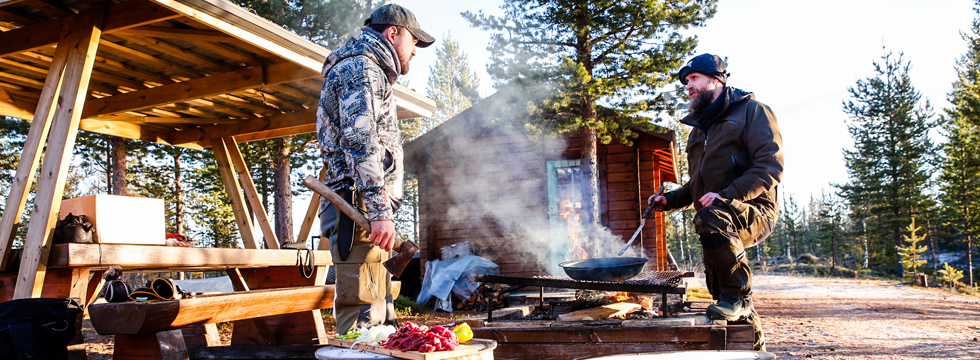
For what distances have you used your riflescope?
In the last hours of our hunt, we spotted the moose calf from some distance away. Moving deep into the darkness of the forrest, it was still easy to spot the moose and give it a well placed shot, using the illuminated reticle. The ability to pinpoint a target at medium range, and finishing the ordeal with a close range shot at lowest magnification, tells you a lot about the versatility and performance of the riflescope.
What was the most important moment for you on this hunting trip?
On a trip like this you experience so many things that you will never forget. But if I have to name one moment that really meant a lot to me, it would be sitting by the river after the moose was down. We had started a small log fire and Tommy had produced dried reindeer meat. Suddenly he exclaimed in his slow northern Swedish accent: “Next time you don’t need a guide my friend. I’ll let you run the dog yourself.” The compliment was not a joke, or a nicety to make a client feel good about himself. It was a simple stated fact, from a man that only says what he means. In the fading sunlight, it was hard not to feel a sting of pride and that I had passed the test as a hunter in this harsh northern land, high above the arctic circle.
Year of the Dog – Part #1 “Difficult choices”
Hunting with a Baying Dog
Swedish Lapland: The Magic of the North
Hunter David Carsten Pedersen speaks about his impressions with the hunting guide Tommy and the baying dog Tiko in swedish Lapland. Tommy has been a guide in Lapland for many years, and is an expert in the ancient skill of hunting moose over baying dogs. The technique used by Scandinavian hunters since the first people came to Europe in the stone ages, has developed a bond between the hunter and the dog where the dog has become a trusted friend and hunting partner.

An owl was watching us from a tree this morning. When I see an owl I always find the moose.
After three intensive days the voice oft the barking dog rings out like a concert through the forest. Looking at Tommys GPS, we could see where the dog was barking happily. Somewhere in front of him, the moose had to be standing. Judging from the distance to the dog, we should be able to get to him, before the sun came down. In front of us lay a giant frozen bog, its surface a giant glassy hockey rink. We started to run, keeping our center of gravity low, and our eyes fixed on the sound of that dog in the distance.
People in Lapland have a strong bond with nature. The deep dark sound of a circling raven, made me look up just as we entered the tree line. It seemed to be following us. “A good sign,” I noted to Tommy. “I also got a good signals from the birds.” “An owl was watching us from a tree this morning. When I see an owl I almost always find the moose.” In northern Lapland it’s easy to get a bit superstitious. People up here still have a strong bond with nature.
The moose can’t be far away anymore. With the sky already turning pink this was no time to scorn a good omen. We needed all the help we could get, to crown our hunt for the moose with success. Keeping our bodies completely still, we waited for the sound to come back. The distance to the dog couldn’t be far. The only way to get closer to the moose was to use the sounds of the dogs bark to mask our footsteps in the crunchy, boggy, undergrowth. But the sounds had stopped. “Be ready. He might push them out towards us,” whispered Tommy. Dialing down my VICTORY V8 Driven Hunt riflescope from ZEISS to get the largest possible field of view, I started to prepare myself for that moment where the moose might break.
Suddenly the dog came out of the clearing, running towards us at a steady pace. At first my heart dropped. Why did he loose the moose now? But then I understood. Tiko hadn’t lost it. He just came back to see if we were in position. Soon the barking started again. Something big was coming our way. This was going to be a one shot opportunity.
A perfect hunt.
On the edge of the river, lay the body of a big moose calf. This was the goal we had worked so hard toward. A physical manifestation of the connection between the hunter, the dog, the animals, and a community that relies heavily on our hunt skills to bring home the meat.
“This was a perfect hunt,” Tommy exclaimed. “The meat of the calf is beautiful, and you didn’t hesitate when you had the chance.” Overwhelmed by the compliments of my otherwise stoic hunting partner, I lifted my coffee mug, toasting him, the moose and the dog with the Scandinavian: “Skål.”
In the dying light of the sunset, a raven suddenly came flying out of the forest. Behind it, a small owl following close by. None of us said anything. We just smiled. In Lapland you have to be prepared for anything. Even those things you can’t always explain.
Hunting with Baying Dogs
A Hunting Adventure in Canada
The Right Preparation goes Hand in Hand with Extensive Training
For ZEISS Pro Hunter David Carsten Pedersen this dream came true when he went to British Columbia, a province located on the west coast of Canada. “I want to go where I’ve never been, see beyond the horizon and learn as much from nature as it’s willing to show.” In a campfire interview the ZEISS athlete reports on his fascinating trip, about the perfect equipment package for an adventure like this and how to turn your hunting trip into an unforgettable, once in a lifetime experience.
In-Depth Preparation and Planning
A hunt like this, in the backcountry of British Columbia, requires in-depth preparation and planning. Before getting started, you have to think strictly about every little aspect of the journey. What goes in your backpack? What is absolutely essential and what may be expendable? You have to think about weight and about necessities. The right equipment is of the greatest importance, because the whole trip stands and falls with it. The clothing, the rifle, the binoculars, the scope – everything needs to work flawlessly and in all weather conditions. Don’t let sunshine, rain, snow or mist determine your success or failure.
Extensive Training
The right preparation goes hand in hand with . The hunter has to train with the rifle, train with the scope and train at any distance imaginable. For David, this is a really important aspect. “Also train on distances that are that far that you think – OK – this is out of my comfort zone. Because once you’re here, and the chance appears, you don’t want any doubt. You want to know: I can make that shot and I’m going to make that shot.”
Enjoy the Beauty of the Mountains
The most important thing on a wilderness hunt is enjoying it. Enjoy the beauty of the mountains, the freshness of the air and the sounds and smells of nature in its wildest form. Even the smallest things can turn your trip into a valuable memory. Just be open-minded and notice the details of your adventure: the frost that sparkles in the sunshine, a bird you’ve never seen before, the silence and purity of nature. Besides all this, don’t expect everything to be easy, because the tough conditions and the challenges of the wilderness will push you to the limits of your capacity. But exactly that will keep you going and make you even more determined. “Your mind grows higher, your thoughts drift and you become part of your surroundings. But you have to keep your focus, train your eyes and your mind to keep sharp and look for that one crucial detail that determines all the rest.”
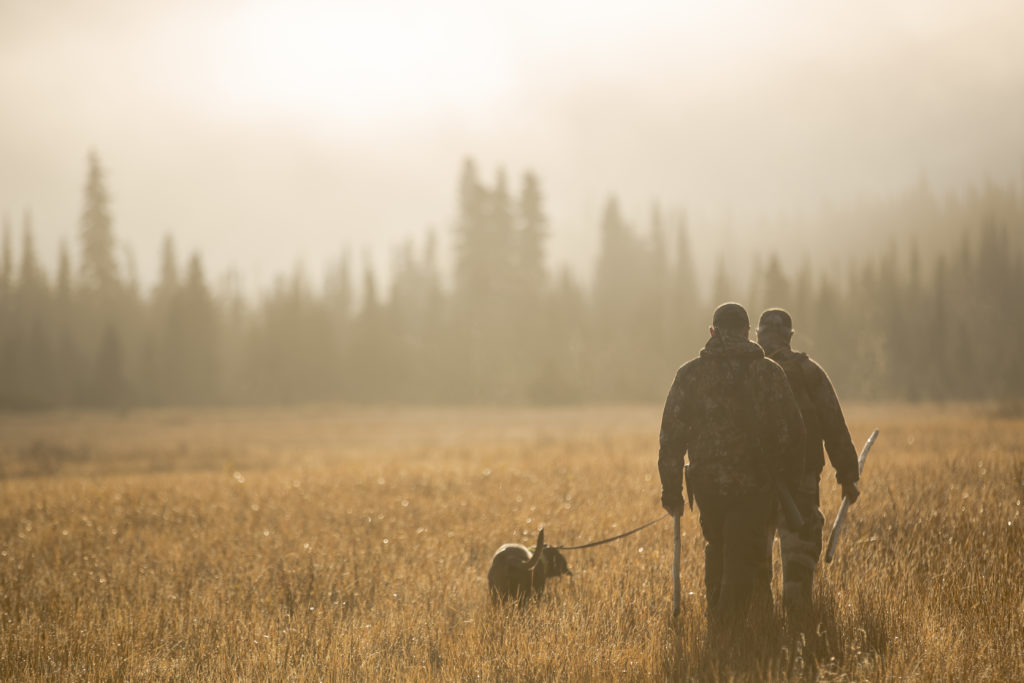
A Wilderness Hunt demands Reliable and Functional Equipment
On his hunting adventure David tested the ZEISS VICTORY SF binoculars and the ZEISS VICTORY V8 1.8-14×50 riflescope. A wilderness hunt demands reliable and functional equipment and the ZEISS premium products fit the hunter’s needs perfectly. “A good pair of binoculars can make the difference between seeing the animal or losing the animal”. On a trip like this, it is important that they are light, fast, easy to use and have a wide field of view. Therefore, the ZEISS VICTORY SF binoculars are absolutely the right choice. They deliver high-contrast, bright images that allow you to see even the finest details in poor light. With a maximum of wearing comfort they are the optimal products for those extra-challenging hunts in tough conditions. David feels totally certain “I can trust them a hundred percent. Even in bad rain and snow, they performed very, very well”.
The Victory V8 is the Ideal Companion in any Situation
The VICTORY V8 1.8-14×50 riflescope also helps David to achieve his goals. Especially the 1.8 magnification enables fast and reliable targeting and quick shots on running game, at short distances as well as at long distances. On a wilderness hunt, the conditions can change in a matter of seconds and you have to be prepared for everything. As a compact all-rounder, the VICTORY V8 is the ideal companion in any situation. No riflescope has ever been this flexible and versatile. The V8 provides an extremely wide range of possible uses and maximum accuracy at any distance. David is obviously impressed: “It’s really amazing to have so many options and so many opportunities in just one package!”
For David Carsten Pedersen, the wilderness hunt in British Columbia was a great adventure and definitely a once in a lifetime experience. “You never know if you’re going to succeed, or maybe you do – because hunting is not about the end, it’s about the moments you experience while you search for other things. It’s about the small things in the big picture and the details in the great story, because in reality, it’s not the goal but the journey that shapes us”.
